Falcom STEPPII-56 GSM/GPS unit User Manual Vorlage f r Dokumente
Falcom GmbH GSM/GPS unit Vorlage f r Dokumente
Falcom >
UserMan
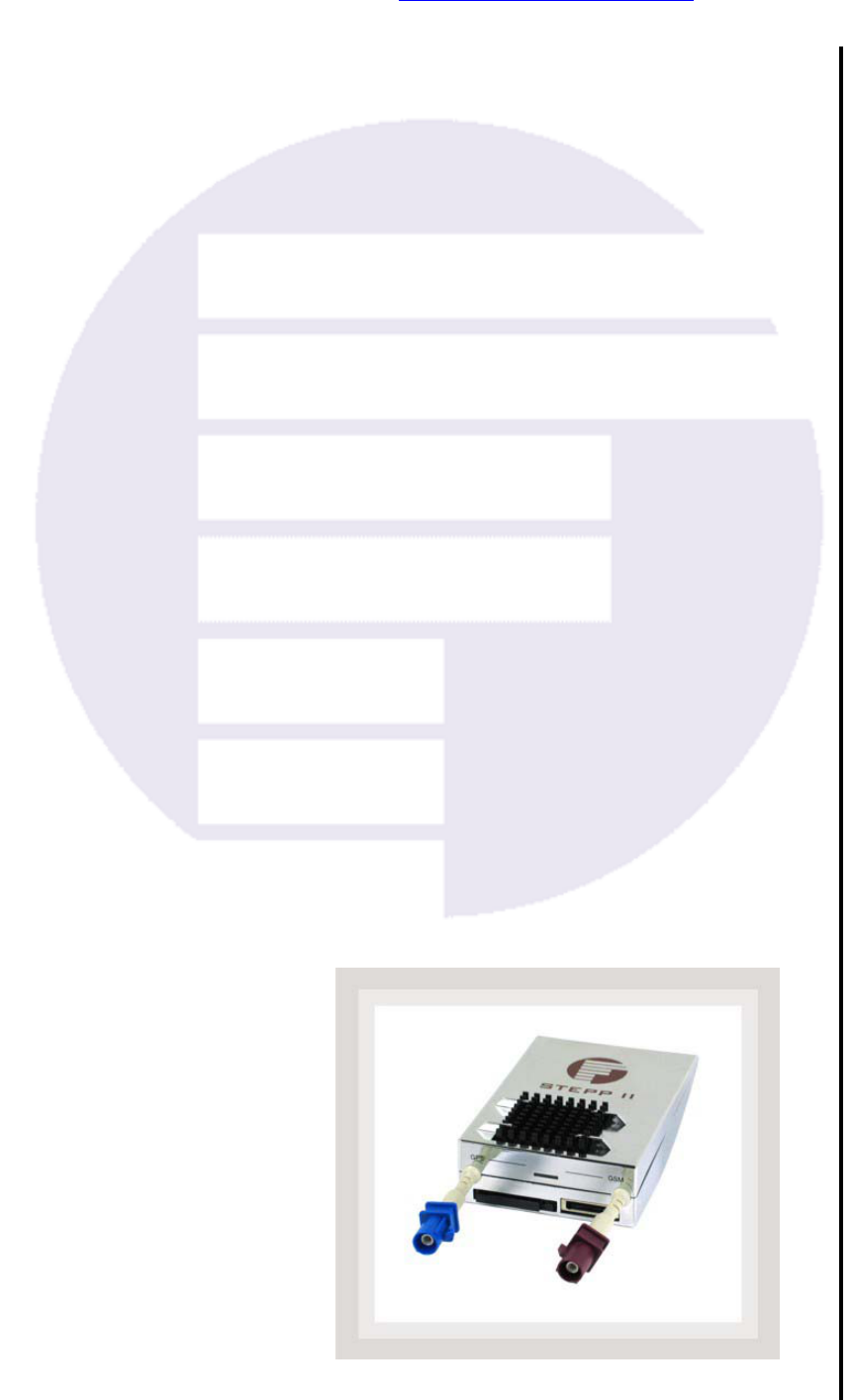
This document is available at HTTP://WWW.FALCOM.DE/ .
STEPP II
Hardware description
Version 1.01

STEPP II HARDWARE DESCRIPTION VERSION 1.01
Index of contents
0 INTRODUCTION ..............................................................4
0.1 GENERAL........................................................................................................................................ 4
0.2 CIRCUIT CONCEPT........................................................................................................................... 5
0.3 SCOPE OF DELIVERY ....................................................................................................................... 6
0.4 USED ABBREVIATIONS.................................................................................................................... 6
0.5 RELATED DOCUMENTS.................................................................................................................... 7
1 SECURITY .........................................................................8
1.1 GENERAL INFORMATION................................................................................................................. 8
1.2 EXPOSURE TO RF ENERGY.............................................................................................................. 8
1.3 EFFICIENT MODEM OPERATION ....................................................................................................... 8
1.4 ANTENNA CARE AND REPLACEMENT .............................................................................................. 9
1.5 DRIVING ......................................................................................................................................... 9
1.6 ELECTRONIC DEVICES..................................................................................................................... 9
1.7 VEHICLE ELECTRONIC EQUIPMENT ................................................................................................. 9
1.8 MEDICAL ELECTRONIC EQUIPMENT ................................................................................................ 9
1.9 AIRCRAFT....................................................................................................................................... 9
1.10 CHILDREN .................................................................................................................................... 10
1.11 BLASTING AREAS.......................................................................................................................... 10
1.12 POTENTIALLY EXPLOSIVE ATMOSPHERES ..................................................................................... 10
1.13 NON-IONIZING RADIATION............................................................................................................ 10
2 SAFETY STANDARDS ...................................................11
3 TECHNICAL DATA........................................................12
3.1 GENERAL SPECIFICATIONS OF TERMINAL STEPP II...................................................................... 12
3.1.1 Power consumption ..................................................................................................................... 13
3.1.2 Operating temperatures................................................................................................................ 13
3.2 TECHNICAL SPECIFICATIONS OF GSM/GPRS ENGINE*................................................................. 14
3.2.1 Air interface of the STEPP II GSM/GPRS part........................................................................... 16
3.3 TECHNICAL SPECIFICATIONS OF GPS RECEIVER ........................................................................... 16
3.4 NMEA DATA MESSAGE ................................................................................................................ 17
4 FUNCTIONAL DESCRIPTION.....................................19
4.1 HOW DOES IT WORKS.................................................................................................................... 19
4.2 FALCOM STEPP II TYPICAL APPLICATIONS............................................................................... 21
5 STEPP II APPLICATION INTERFACE ......................23
5.1 POWER SUPPLY ............................................................................................................................. 23
5.1.1 Power up/down scenarios ............................................................................................................ 23
5.1.2 Power supply pins (14, 15 and 16) on the 16-pin connector........................................................ 23
5.1.3 Automatic shutdown.................................................................................................................... 24
5.1.3.1 Over voltage shutdown................................................................................................................................. 24
5.2 AUTOMATIC GPRS MULTISLOT CLASS CHANGE .......................................................................... 24
5.3 DETERMINING THE EXTERNAL EQUIPMENT TYPE......................................................................... 24
6 HARDWARE INTERFACES .........................................26
6.1 INTERFACE A (16-PIN MOLEX 43045-1609)................................................................................. 27
6.1.1 Description of the 16-pin connector ............................................................................................ 27
6.1.2 Special pin description................................................................................................................. 28
6.1.2.1 Analog inputs (pin 2, 4)................................................................................................................................ 28
6.1.2.2 Inputs (pin 6, 8, 10, 12) ................................................................................................................................ 29
6.1.2.3 Outputs (pin 5, 7, 9, 11) ............................................................................................................................... 30
6.1.2.4 VBAT (pin 14) .............................................................................................................................................. 30
6.1.2.5 Ignition (pin 13) ........................................................................................................................................... 32
This confidential document is a property of FALCOM GmbH and may not be copied or circulated without previous permission.
Page 1

STEPP II HARDWARE DESCRIPTION VERSION 1.01
6.2 INTERFACE B (SIM CARD INTERFACE MOLEX-91228-0002)........................................................ 33
6.3 INTERFACES C AND D................................................................................................................... 34
6.4 INTERFACE E (AMP 558556-1 CONNECTOR)............................................................................... 34
6.4.1 The 15- pin connector description ...............................................................................................35
6.4.2 Special pin description................................................................................................................. 35
6.4.2.1 VC 5 ............................................................................................................................................................. 35
6.4.2.2 Boot select.................................................................................................................................................... 36
6.4.2.3 Serial communication signals (RxA, TxA).................................................................................................... 36
6.4.2.4 Speaker outputs characteristics.................................................................................................................... 36
6.5 INTERFACE F (LED’S DESCRIPTION) ............................................................................................ 36
6.5.1 Interface E (Mounting holes)....................................................................................................... 37
6.5.1.1 Mounting the cradle to the terminal............................................................................................................. 38
6.5.1.2 Placing the terminal..................................................................................................................................... 38
7 HOUSING .........................................................................39
8 STEPP II-MOUNTING CRADLE..................................40
9 RF EXPOSURES..............................................................41
10 APPENDIX .......................................................................42
10.1 SCHEMATICS................................................................................................................................. 42
10.1.1 Installation guidance for 16-pin Molex connector....................................................................... 42
10.1.2 Installation guidance for 15-pin AMP connector......................................................................... 43
Version history:
Version number Author Changes
1.00 Fadil Beqiri Initial release
1.01 Fadil Beqiri - Description improved.
- Some images changed.
This confidential document is a property of FALCOM GmbH and may not be copied or circulated without previous permission.
Page 2

STEPP II HARDWARE DESCRIPTION VERSION 1.01
Cautions
Information furnished herein by FALCOM are accurate and reliable.
However, no responsibility is assumed for its use.
Please, read carefully the safety precautions.
If you have any technical questions regarding this document or the
product described in it, please contact your vendor.
General information about FALCOM and its range of products are
available at the following internet address: http://www.falcom.de/
Trademarks
Some mentioned products are registered trademarks of their respective
companies.
Copyright
The STEPP II user’s guide is copyrighted by FALCOM GmbH with all
rights reserved. No part of this user’s guide may be produced in any form
without the prior written permission of FALCOM GmbH.
FALCOM GmbH.
No patent liability is assumed with respect to the use of the information
contained herein.
This confidential document is a property of FALCOM GmbH and may not be copied or circulated without previous permission.
Page 3

STEPP II HARDWARE DESCRIPTION VERSION 1.01
0 Introduction
0.1 General
This description is focused on the GSM/GPRS and GPS terminal STEPP II
from FALCOM GmbH. It contains information about purpose and use of the
STEPP II concept.
In order quickly to start and immediately and comprehensive to use all
functions and to avoid any mistakes of STEPP II terminal on your utilization,
we recommend to read the following references and suggestions for using your
new STEPP II terminal.
The STEPP II is a Plug-and-Play device which provides a powerful state-of-the
art technologies (GSM, GPS, internet) and makes them available for quick and
easy integration into a number of applications for the vertical and horizontal
market. The new STEPP II concept is a Full Type Approved combined
GSM/GPRS/GPS Smart Terminal.
The compact design of the GSM/GPRS/GSM STEPP II terminal integrates it
in an all-in-one solution. This combination concept and internal embedded
software (known as firmware) make it available to be used in a wild range of
tracking solutions such as fleet management, vehicle tracking, navigation,
emergency calling, location-based services and many others.
The STEPP II is designed to be used on any GSM network. This single
compact device is Tri-band GSM/GPRS engine that works on the three
frequencies GSM 900MHz, GSM 1800 MHz and GSM 1900 MHz, it supports
also state-of-art GPS technology for satellite navigation.
The embedded firmware based on the eCos operating system for the TCP/IP
communication protocol (TCP/IP stack) converts data streams into data packets
and makes GPRS traffic possible for industrial and automotive applications.
No PDA or laptop needed for establishing a GPRS connection, it has its own
TCP/IP and PPP stack and will work as a stand-alone terminal. STEPP II
features GPRS multislot class 10 and supports the GPRS coding schemes CS-1,
CS-2, CS-3 and CS-4. The STEPP II terminal can send and receive data by
GSM and GPRS networks. It supports SMS, data and voice calls as well as
internet and e-mail. The STEPP II terminal can be easily controlled by using
SMS and PRSF commands provided on the embedded software for all kinds of
operations.
The internal advanced GPS system uses twelve parallel channels, providing
highly accurate positional, speed, time and date information. Using satellite
signals the embedded GPS module enables users to determine the position of
device anywhere in the world. The STEPP II module has an integrated TCXO
which also improves the GPS system performance. Due to the temperature-
stabilizing its position is determined more precisely.
A compact “stacked FLASH/SRAM” device stores the STEPP II software in
the FLASH memory section of terminal, and a static RAM section provides the
additional storage capacity required by GPRS connectivity.
Regarding the internal temperature of system, a built-in active cooling &
heating system improves significantly system performance. Due to this
electronic component, the STEPP II device is capable to operate in range from
–40 °C to +85 °C. This component controls automatically the current
This confidential document is a property of FALCOM GmbH and may not be copied or circulated without previous permission.
Page 4
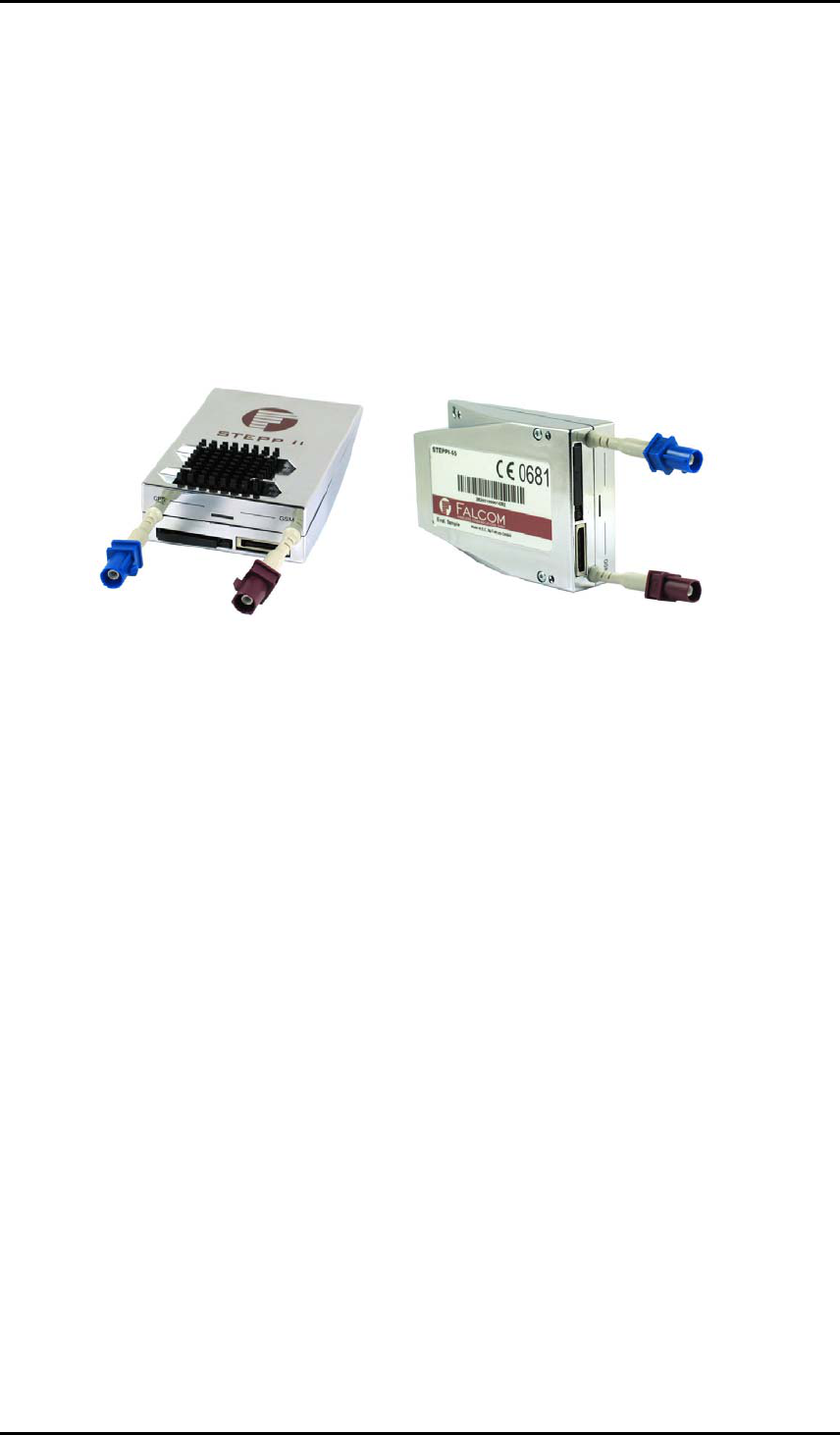
STEPP II HARDWARE DESCRIPTION VERSION 1.01
temperature of the terminal. It activates or deactivates the heating/cooling
process to keep the internal temperature of STEPP II terminal under the
required range for a normal operation.
The physical interfaces to the terminal application are made through integrated
connectors. These are required for controlling the unit, receiving GPS location
data, transferring data and audio signals and providing power supply lines.
STEPP II provides a serial interface (2-wire and GND on the 16-pin AMP
connector) giving you maximum flexibility for locally use.
The STEPP II contains an intelligent on-board charging management
compatible with Li-Ion batteries. Lines are wired to the 16-pin connector which
enable a direct connection to a Li-Ion battery.
Figure 1 shows the front and back side of the STEPP II.
a) front side b) back side
Figure 1: Front and back side of STEPP II
0.2 Circuit concept
The STEPP II architecture includes the following major functional components
(see figure 2):
architecture integrates:
high-performance Dual Band GSM/GPRS core
12 parallel channel low-power GPS core
ARM7TDMI processor that controls all functions of the system
Power Control circuitry for Li-Ion backup batteries
Cooling/Heating system
Audio amplifier
Interface circuitry
physical interfaces:
16-pin Molex connector (Type: Molex 43045-1609, and counterpart:
Casing: 43025-1600 and Box type spring contact: 43031-0001) for
power supply and I/O’s
15-pin AMP connector (Type: AMP5-558556-1, and counterpart:
558666-1) for audio interfaces and software update
SIM Card reader (Type: Molex-91228-0002 small SIM Card)
This confidential document is a property of FALCOM GmbH and may not be copied or circulated without previous permission.
Page 5

STEPP II HARDWARE DESCRIPTION VERSION 1.01
GSM antenna interface (Type: Connector 50 Ω Fakra/Radiall SMB-
male)
GPS antenna interface (Type: Connector 50 Ω Fakra/Radiall SMB-
male)
Figure 2: Architecture of the STEPP II terminal
0.3 Scope of delivery
Check the contents of the package. In case of damaged or missing any item,
please contact your dealer immediately.
Concerning the STEPP II, there are two different terminals which operate in
the different frequencies:
1. STEPP-II-55 is a Tri-band device which operates in the three
frequencies GSM 900 MHz, DCS 1800 MHz and PCS 1900 MHz, and
is available to use in the European and Asia Networks.
2. STEPP-II-56 is a Tri-band device which operates in the three
frequencies GSM 850 MHz, DCS 1800 MHz and PCS 1900 MHz, and
is available to use in the American Networks.
Regarding the electrical interfaces, mechanical specification (dimension, form
etc.) and electrical specification they are the same to both terminals.
Please, note that according to your requirements you can choose the desired
STEPP II device.
0.4 Used abbreviations
Abbreviation Description
ASIC Application Specific Integrated Circuit
DOP Dilution of Precision
GPS Global Positioning System
GSM Global Standard for Mobile Communications
GGA GPS Fixed Data
HDOP Horizontal DOP
This confidential document is a property of FALCOM GmbH and may not be copied or circulated without previous permission.
Page 6

STEPP II HARDWARE DESCRIPTION VERSION 1.01
Abbreviation Description
HW Hardware
IMEI International Mobile Equipment Identity
I/O Input/Output
NMEA National Marine Electronics Association
PRN Pseudorandom Noise Number – The Identity of GPS satellites
RF Radio Frequency
RTC Real Time Clock
RXQUAL Received Signal Quality
SIM Subscriber Identification Module
SMS Short Message Service
SRAM Static Random Access Memory
TA Terminal Adapter
TE Terminal Equipment
TP Transmit Protocol
TTFF Time to First Fix
SA Selective Availability
WAAS Wide Area Augmentation System
MSK Minimum Shift Keying
Table 1: Used abbreviations
0.5 Related documents
1. ETSI GSM 07.05:“Use of Data Terminal Equipment–Data Circuit
terminating Equipment interface for Short Message Service and Cell
Broadcast Service”
2. ETSI GSM 07.07“AT command set for GSM Mobile Equipment”
3. ITU-T V.25ter “Serial asynchronous automatic dialing and control”
4. SiRF binary and NMEA protocol specification;
www.falcom.de/Service/Manuals/SiRF
5. stepp_II_getting_started.pdf
6. stepp_II_software_2.0RC1_manual.pdf
7. stepp_II_software_1.6.2_manual.pdf
8. falcom_eCos_SDK_user_guide.pdf
This confidential document is a property of FALCOM GmbH and may not be copied or circulated without previous permission.
Page 7

STEPP II HARDWARE DESCRIPTION VERSION 1.01
1 Security
IMPORTANT FOR THE EFFICIENT AND SAFE OPERATION OF YOUR
GSM-MODEM, READ THIS INFORMATION BEFORE USE!
Your cellular engine STEPP II is one of the most exciting and innovative
electronic products ever developed. With it you can stay in contact with your
office, your home, emergency services and others, wherever service is
provided.
This chapter contains important information for the safe and reliable use of the
STEPP II. Please read this chapter carefully before starting to use the cellular
engine STEPP II.
1.1 General information
Your STEPP II device utilizes the GSM/GPRS/GPS standard for cellular
technology. GSM/GPRS is a newer radio frequency („RF“) technology than
the current FM technology that has been used for radio communications for
decades. The GSM standard has been established for use in the European
community and elsewhere. Your modem is actually a low power radio
transmitter and receiver. It sends out and receives radio frequency energy.
When you use your modem, the cellular system handling your calls controls
both the radio frequency and the power level of your cellular modem.
1.2 Exposure to RF energy
There has been some public concern about possible health effects of using
GSM modem. Although research on health effects from RF energy has focused
for many years on the current RF technology, scientists have begun research
regarding newer radio technologies, such as GSM. After existing research had
been reviewed, and after compliance to all applicable safety standards had been
tested, it has been concluded that the product is fit for use.
If you are concerned about exposure to RF energy there are things you can do
to minimize exposure. Obviously, limiting the duration of your calls will
reduce your exposure to RF energy. In addition, you can reduce RF exposure
by operating your cellular modem efficiently by following the guidelines
below.
1.3 Efficient modem operation
In order to operate your modem at the lowest power level, consistent with
satisfactory call quality please take note of the following hints.
If your modem has an extendible antenna, extend it fully. Some models
allow you to place a call with the antenna retracted. However, your modem
operates more efficiently with the antenna fully extended.
Do not hold the antenna when the modem is „IN USE“. Holding the
antenna affects call quality and may cause the modem to operate at a
higher power level than needed.
This confidential document is a property of FALCOM GmbH and may not be copied or circulated without previous permission.
Page 8

STEPP II HARDWARE DESCRIPTION VERSION 1.01
1.4 Antenna care and replacement
Do not use the modem with a damaged antenna. If a damaged antenna comes
into contact with the skin, a minor burn may result. Replace a damaged antenna
immediately. Consult your manual to see if you may change the antenna
yourself. If so, use only a manufacturer-approved antenna. Otherwise, have
your antenna repaired by a qualified technician.
Use only the supplied or approved antenna. Unauthorized antennas,
modifications or attachments could damage the modem and may contravene
local RF emission regulations or invalidate type approval.
1.5 Driving
Check the laws and regulations on the use of cellular devices in the area where
you drive. Always obey them. Also, when using your modem while driving,
please pay full attention to driving, pull off the road and park before making or
answering a call if driving conditions so require. When applications are
prepared for mobile use they should fulfill road-safety instructions of the
current law!
1.6 Electronic devices
Most electronic equipment, for example in hospitals and motor vehicles is
shielded from RF energy. However, RF energy may affect some
malfunctioning or improperly shielded electronic equipment.
1.7 Vehicle electronic equipment
Check your vehicle manufacturer’s representative to determine if any on board
electronic equipment is adequately shielded from RF energy.
1.8 Medical electronic equipment
Consult the manufacturer of any personal medical devices (such as
pacemakers, hearing aids, etc.) to determine if they are adequately shielded
from external RF energy.
Turn your STEPP II device OFF in health care facilities when any regulations
posted in the area instruct you to do so. Hospitals or health care facilities may
be using RF monitoring equipment.
1.9 Aircraft
Turn your STEPP II OFF before boarding any aircraft.
Use it on the ground only with crew permission.
Do not use it in the air.
To prevent possible interference with aircraft systems, Federal Aviation
Administration (FAA) regulations require you to have permission from a crew
member to use your modem while the plane is on the ground. To prevent
interference with cellular systems, local RF regulations prohibit using your
modem whilst airborne.
This confidential document is a property of FALCOM GmbH and may not be copied or circulated without previous permission.
Page 9

STEPP II HARDWARE DESCRIPTION VERSION 1.01
1.10 Children
Do not allow children to play with your STEPP II device. It is not a toy.
Children could hurt themselves or others (by poking themselves or others in the
eye with the antenna, for example). Children could damage the modem or
make calls that increase your modem bills.
1.11 Blasting areas
To avoid interfering with blasting operations, turn your unit OFF when in a
“blasting area” or in areas posted: „turn off two-way radio“. Construction crew
often use remote control RF devices to set off explosives.
1.12 Potentially explosive atmospheres
Turn your STEPP II device OFF when in any area with a potentially explosive
atmosphere. It is rare, but your modem or its accessories could generate sparks.
Sparks in such areas could cause an explosion or fire resulting in bodily injury
or even death.
Areas with a potentially explosive atmosphere are often, but not always, clearly
marked. They include fuelling areas such as petrol stations; below decks on
boats; fuel or chemical transfer or storage facilities; and areas where the air
contains chemicals or particles, such as grain, dust or metal powders.
Do not transport or store flammable gas, liquid or explosives, in the
compartment of your vehicle which contains your modem or accessories.
Before using your modem in a vehicle powered by liquefied petroleum gas
(such as propane or butane) ensure that the vehicle complies with the relevant
fire and safety regulations of the country in which the vehicle is to be used.
1.13 Non-ionizing radiation
As with other mobile radio transmitting equipment users are advised that for
satisfactory operation and for the safety of personnel, it is recommended that
no part of the human body be allowed to come too close to the antenna during
operation of the equipment.
The radio equipment shall be connected to the antenna via a non-radiating
50 Ohm coaxial cable.
The antenna shall be mounted in such a position that no part of the human body
will normally rest close to any part of the antenna. It is also recommended to
use the equipment not close to medical devices as for example hearing aids and
pacemakers.
This confidential document is a property of FALCOM GmbH and may not be copied or circulated without previous permission.
Page 10

STEPP II HARDWARE DESCRIPTION VERSION 1.01
2 Safety standards
This GSM/GPS modem complies with all applicable RF safety standards.
The embedded GSM/GPRS/GPS modem meets the safety standards for RF
receivers and the standards and recommendations for the protection of public
exposure to RF electromagnetic energy established by government bodies and
professional organizations, such as directives of the European Community,
Directorate General V in matters of radio frequency electromagnetic energy.
This confidential document is a property of FALCOM GmbH and may not be copied or circulated without previous permission.
Page 11

STEPP II HARDWARE DESCRIPTION VERSION 1.01
3 Technical data
3.1 General specifications of terminal STEPP II
Power supply:
Supply voltage from +10.8 V to +32.0 V
(absolute maximum ratings) suitable for direct
connection to an automotive +12V or +24V DC
supply.
Charging:
Supports externally connection to a Li-Ion
battery (Note that the Li-Ion battery is not a part
of terminal STEPP II).
Temperature:
Normal operation (without connected battery):
-40 °C to +85 °C (see chapter 3.1.2 for further
details)
Evaluation kit:
The STEPP II Eval-Board is designed to test,
evaluate and make basis configuration to enable
remote monitoring/configuration of the
FALCOM STEPP II. It provides a sample
configuration for application.
Physical characteristics:
Size: 55.0 ± 0.15 mm x 80.0 ± 0.15 mm x 25.0 ±
0.15 mm
Weight: ca. 80 g
Audio:
2 x Microphone, 2 x Speaker
Firmware upgrade:
STEPP II firmware upgradeable over serial
interface
Serial Interface Setting:
Full duplex serial communication, CMOS level
2-wire (RxA and TxA) serial communication
Baud rate: 9600 bps on the serial port
8 data bits, no parity, 1 stop bit, no hardware
Casing:
Fully shield
This confidential document is a property of FALCOM GmbH and may not be copied or circulated without previous permission.
Page 12

STEPP II HARDWARE DESCRIPTION VERSION 1.01
3.1.1 Power consumption
Test conditions:
All measurements have been performed at Tamb= 25 °C, VIN+ = 12 VDC
and 24 VDC. The heating/cooling system was not active.
Average current at +12 V DC (without connected battery)
850/
900
1800/
1900 MHz GSM band
95 95 mA in idle mode (base station sends at -85 dBm)
170 140 mA in transmit mode at power level 7/3
GPS/GSM on
(Operating with
firmware 1.6.2) 205 160 mA in transmit mode at power level 5/0
(maximum)
GPS/GPRS on
(Operating with
firmware 2.0RC1)
260 mA
in receive mode at maximum power level 5
(3 x downstream +2 x upstream using
Coding Scheme 4 (CS-4))
Table 2: Power supply and current consumption at 12 V DC
Average current at +24 V DC (without connected battery)
850/
900
1800/
1900 MHz GSM band
55 55 mA in idle mode (base station sends at -85 dBm)
102 85 mA in transmit mode at power level 7/3
GPS/GSM on
(Operating with
firmware 1.6.2) 120 95 mA in transmit mode at power level 5/0
(maximum)
GPS/GPRS on
(Operating with
firmware 2.0RC1)
190 mA
in receive mode at maximum power level 5
(3 x downstream +2 x upstream using
Coding Scheme 4 (CS-4))
Table 3: Power supply and current consumption at 24 V DC.
3.1.2 Operating temperatures
Parameter Min Typ Max Unit
Ambient temperature (according to GSM 11.10) -40 25 85 °C
Charging temperature (using an external battery) 0 °C +40 °C
Table 4: Operating temperature
This confidential document is a property of FALCOM GmbH and may not be copied or circulated without previous permission.
Page 13

STEPP II HARDWARE DESCRIPTION VERSION 1.01
3.2 Technical specifications of GSM/GPRS engine*
Frequency bands:
Tri band: EGSM 900, GSM 1800, GSM 1900
Tri band: EGSM 850, GSM 1800, GSM 1900
Compliant to GSM Phase 2/2+
GSM class:
Small MS
Transmit power:
Class 4 (2 W) at EGSM900 and GSM850
Class 1 (1 W) at GSM1800 and GSM 1900
GPRS connectivity:
GPRS multi-slot class 10
GPRS mobile station class B
DATA:
GPRS ⇒
GPRS data downlink transfer: max. 85.6 kbps
(see table 3).
GPRS data uplink transfer: max. 42.8 kbps (see
table 5).
Coding scheme: CS-1, CS-2, CS-3 and CS-4.
TCP/IP and PPP-stack.
STEPP II supports two protocols PAP (Password
Authentication Protocol) and CHAP (Challenge
Handshake Authentication Protocol) commonly
used for PPP connections.
Supports of Packet Switched Broadcast Control
Channel (PBCCH) allows you to benefit from
enhanced GPRS performance when offered by
the network operators.
CSD ⇒
CSD transmission rates: 2.4, 4.8, 9.6, 14.4 kbps,
non-transparent, V.110.
Unstructured Supplementary Services Data
(USSD) support.
WAP ⇒
WAP compliant.
SMS:
MT, MO, CB, Text and PDU mode
SMS storage: SIM card plus 25 SMS locations in
the mobile equipment
Transmission of SMS alternatively over CSD or
GPRS. Preferred mode can be user-defined.
This confidential document is a property of FALCOM GmbH and may not be copied or circulated without previous permission.
Page 14

STEPP II HARDWARE DESCRIPTION VERSION 1.01
SIM interface:
Support SIM card: 3 V
Temperature control
and auto switch-off:
Constant temperature control prevents damage to
module STEPP II when the specified
temperature is exceeded. (see chapter 3.1.2 for
further details)
External antenna:
Connected via 50 Ohm antenna connector.
Audio features:
Speech codec modes:
Half Rate (ETS 06.20)
Full Rate (ETS 06.10)
Enhanced Full Rate (ETS 06.50/06.60/06.80)
Adaptive Multi Rate (AMR)
Handsfree operation
Echo cancellation
Noise reduction
Phonebook management:
Supported phonebook types: SM, FD, LD, MC,
RC, ON, ME
Ringing tones:
Offers a choice of 7 different ringing
tones/melodies, easily selectable with AT
command
Real time clock:
Implemented
Timer function:
Programmable via SMS or $PSRF commands
Coding scheme 1 Timeslot 2 Timeslots 4 Timeslots
CS-1: 9.05 kbps 18.1 kbps 36.2 kbps
CS-2: 13.4 kbps 26.8 kbps 53.6 kbps
CS-3: 15.6 kbps 31.2 kbps 62.4 kbps
CS-4: 21.4 kbps 42.8 kbps 85.6 kbps
Table 5: Coding schemes and maximum net data rates over air interface
Please note that the values listed above are the maximum ratings which, in practice, are
influenced by a great variety of factors, primarily, for example, traffic variations and network
coverage.
* Please note that not all features given above (in this chapter) are utilized in
our firmware. Please, refer to the separated manual of the used firmware
which is included on the delivered CD.
This confidential document is a property of FALCOM GmbH and may not be copied or circulated without previous permission.
Page 15

STEPP II HARDWARE DESCRIPTION VERSION 1.01
3.2.1 Air interface of the STEPP II GSM/GPRS part
Test conditions:
All measurements have been performed at Tamb= 25 °C, VIN+ nom = 12 V.
Parameter Min Typ Max Unit
E-GSM 900 880 915 MHz
GSM 850 824 849 MHz
GSM 1800 1710 1785 MHz
GSM 1900 1850 1910 MHz
E-GSM 900 925 960 MHz
GSM 850 869 894 MHz
GSM 1800 1805 1880 MHz
Frequency range
Uplink (MS BTS)
Frequency range
Downlink (BTS MS)
GSM 1900 1930 1990 MHz
E-GSM 900 31 33 35 dBm
GSM 850 31 33 35 dBm
GSM 1800 28 30 32 dBm
GSM 1900 28 30 32 dBm
E-GSM 900 174
GSM 850 124
GSM 1800 374
RF power @ ARP with
50 load
GSM 1900 299 dBm
E-GSM 900 45 MHz
GSM 850 45 MHz
GSM 1800 95 MHz
Duplex spacing
GSM 1900 80 MHz
Carrier spacing 200 kHz
Multiplex, Duplex TDMA/FTDMA, FDD
Time slots per TDMA frame 8
Frame duration 4.615 ms
Time slot duration 577 µs
GMSK
E-GSM 900 -102 -107 dBm
GSM 850 -102 -107 dBm
GSM 1800 -102 -106 dBm
Modulation
Receiver input sensitivity @
ARP
BER Class II < 2.4 %
GSM 1900 -102 -105.5 dBm
Table 6: Air Interface
3.3 Technical specifications of GPS receiver
GPS features:
OEM single board 12 channel GPS receiver, L1
1575.42 MHz, C/A code 1,023 MHz chip rate.
GPS receiver with SiRFstarIIe/LP chip set
Processor type ARM7/TDMI
SiRF GSW2, version 2.20 (adapted for tracking
solutions).
Accuracy:
This confidential document is a property of FALCOM GmbH and may not be copied or circulated without previous permission.
Page 16
Position 10 meters CEP without SA.
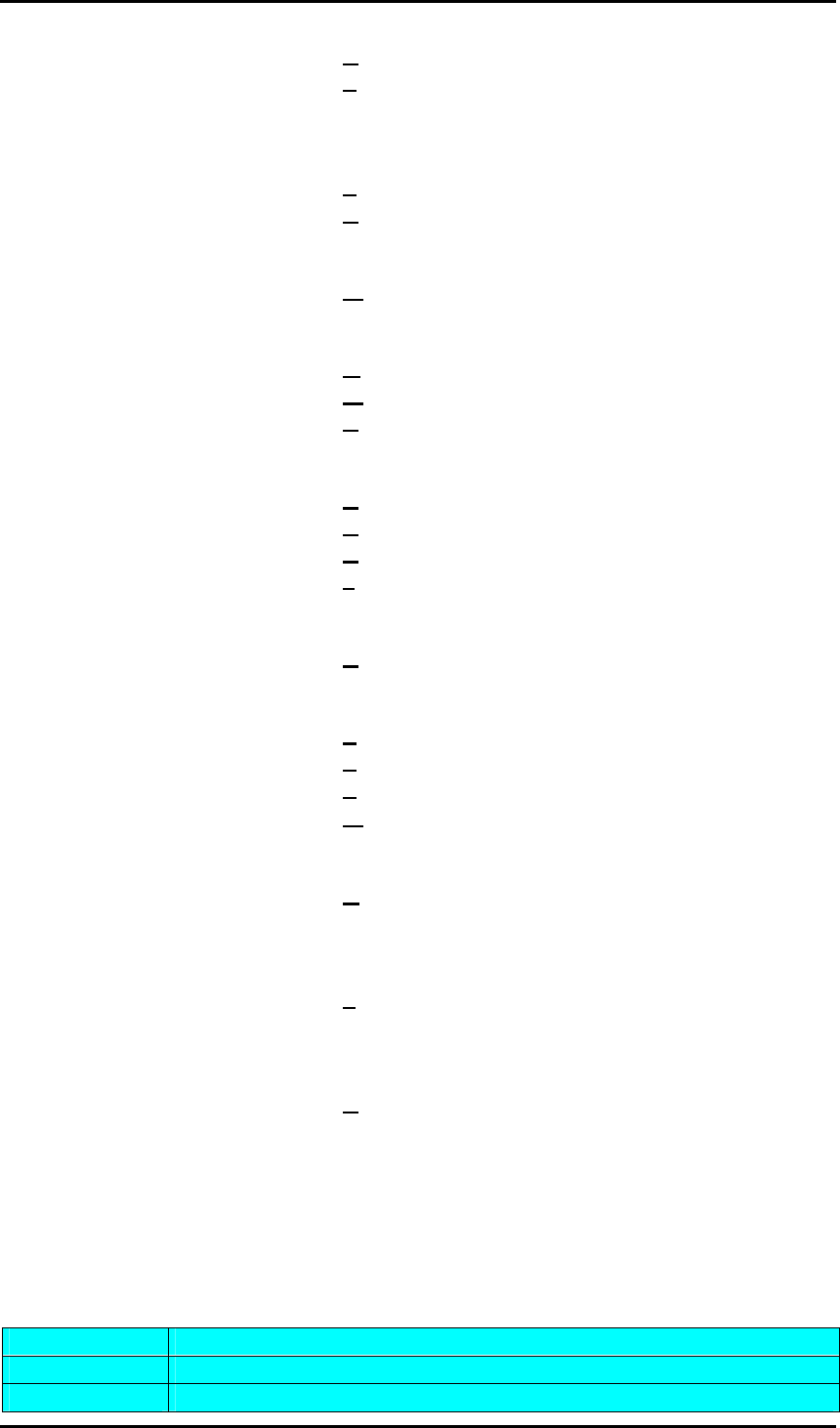
STEPP II HARDWARE DESCRIPTION VERSION 1.01
Velocity 0.1 meters/second, without SA
Time 1 microsecond synchronized to GPS time
DGPS Accuracy:
Position 1 to 5 meters, typical
Velocity 0.05 meters/second, typical
Datum:
WGS-84.
Acquisition Rate:
Hot start <8 sec, average
Warm start <38 sec, average
Cold start <45 sec, average
Dynamic Conditions:
Altitude 18,000 meters (60,000 feet) max.
Velocity <515 meters/second (1000 knots) max.
Acceleration 4 g, max.
Jerk 20 meters/second³, max.
Casing:
Fully shield
Time – 1 PPS Pulse:
Level CMOS.
Pulse duration 100 ms
Time reference At the pulse positive edge
Measurements Aligned to GPS second, ± µs
Supported protocols:
NMEA Msg.: GLL, GGA, RMC, VTG, GSV,
GSA
External antenna:
Separate GPS antenna connector. See figure 37
for details
Memory:
Combo-Memory (2 MB Flash–512 KB SRAM)
3.4 NMEA data message
The STEPP II device delivers data in the NMEA-0183 format.
Table 7 lists each of the NMEA output messages supported by the STEPP II
evaluation receiver and a brief description.
For further description about NMEA see Related documents[4].
Option Description
GGA Time, position and fix type data.
GLL Latitude, longitude, UTC time of position fix and status.
This confidential document is a property of FALCOM GmbH and may not be copied or circulated without previous permission.
Page 17

STEPP II HARDWARE DESCRIPTION VERSION 1.01
GSA GPS receiver operating mode, satellites used in the position solution
and DOP values.
VTG The number of GPS satellites in view satellite ID numbers, elevation,
azimuth and SNR values.
GSV The number of GPS satellites in view satellite ID numbers, elevation,
azimuth and SNR values.
RMC Time, date, position, course and speed data.
Table 7: NMEA Output Messages
This confidential document is a property of FALCOM GmbH and may not be copied or circulated without previous permission.
Page 18

STEPP II HARDWARE DESCRIPTION VERSION 1.01
4 Functional description
4.1 How does it works
It can be powered from +10.8 to +32.0 VDC. It integrates a charging
management which allows attachment to a Li-Ion backup battery. If the battery
voltage is going low, to charge it just supply the terminal (via VC+ and GND
pins) with aforementioned power source (e.g. car battery). The user external
connected battery is internally monitored. A circuit example is shown in the
chapter 6.1.2.4. Attached battery allows operation of terminal for some hours
(it depends on the capacity of user chosen battery pack) in case of operating
voltage (i.e. car battery) failure.
A general purpose terminal providing multiple digital/analogue inputs and
outputs for a different variety of uses.
The STEPP II provides 2 analogue inputs, that are very convenient to monitor a
tachometer generator, a temperature sensor as well fuel level and etc. Circuit
examples for digital inputs are attached on the chapter 6.1.2.1. It also provides
4 digital inputs that can be used to trigger alarm SMS (i.e. they can be
connected to the car alarm, to a door switch or customer specific requirements
(e.g.: Panic button)). Circuit examples for digital inputs are attached in chapter
6.1.2.2. 4 digital outputs are provided to switch on/off external devices. Circuit
examples for digital outputs are attached in chapter 6.1.2.3.
Three other inputs are pre-defined by the manufacturer:
- 1 x Power Supply line which has to be connected to the vehicle
battery (clamp 30) or another power source.
- 2 x Ignition lines which can be connected to the vehicle
starter lock (clamp 15).
To use the STEPP II you need to insert a SIM card (available for SMS, data
and voice calls. The different services, i.e. Voice, Data and SMS depend on
your application) and to install the terminal indoor at the supposed location
(e.g. vehicle, boat etc.). STEPP II comes with a combined GSM/GPS antenna.
To achieve an accurate geographical location of STEPP II, it is important to
place the GPS antenna so that it has a clear view to the sky (no obstacle). The
STEPP II terminal is not water resistant, please, give careful consideration to
the installation location of terminal. The configuration of the terminal can be
done by using a serial interface connection (locally) or over GSM network
(remotely) using SMS commands. Note that, in order to configure the STEPP
II remotely the basis configuration has to be locally executed. Once the basis
configuration of the STEPP II terminal is locally set and stored (using STEPP
II Eval-Board und Configuration software) then by means of provided SMS
and PSRF commands it can be remotely configured or present configuration
can be changed. You can then control it from a remote mobile phone via SMS.
The GPS position or current configuration can be received by means of any
GSM phone or PC connected to a GSM modem (able to send/receive SMS,
data and voice calls). Thus, you will be able remotely to monitor the position of
trucks, cars and boats (with a GSM/GPRS coverage) and to receive an alarm if
the device has moved from a marked position (e.g. if your truck, car or boat has
been stolen), deviates off a route or to detect if a car leaves a country.
This confidential document is a property of FALCOM GmbH and may not be copied or circulated without previous permission.
Page 19

STEPP II HARDWARE DESCRIPTION VERSION 1.01
The FALCOM STEPP II comprises also two audio interfaces available on the
provided connectors:
Two analog audio interfaces, each with a balanced analog microphone
input and a balanced analog earpiece output. Both analog interfaces
provide supply circuits to feed active microphones.
This means you can connect up to two audio devices in any combination. An
audio interface allows the direct connection of a headset. An example of a
possible installation is shown in the Appendix of this manual. The voice
channel of STEPP II allows you to conduct a normal telephone conversation.
For this, STEPP II operates in free-speech mode. Requirements are to connect
a loud speaker (pins 13 and 15) and a free-speech microphone (pins 14 and 16)
on the 16-pin connector interface of the STEPP II.
After that the terminal is connected to the aforementioned power supply, its
actual status is displayed by three LED’s on the front side of terminal. The
red LED indicator will flash during the internal initialization of STEPP II
terminal. If ambient temperature and the voltage of external connected
battery are correct the red LED indicator will switch off.
STEPP II provided LED’s
Name LED mode Function
OFF Terminal is off or turned on and ambient
temperature is OK.
100 ms On/30 ms Off/
100 ms On/1 s Off
Ambient temperature is higher than ca. 40 °C.
The charging/discharging process is turned
off.
100 ms On/1 s Off
Ambient temperature is lower than ca. 0 °C.
The charging/discharging process is turned
off.
BAT
(Red LED*)
100 ms On/3 s Off The voltage of external connected battery is
lower than ca. 3.5 V.
Off Terminal is off or run in SLEEP mode
600 ms On/600 ms Off
No SIM card inserted or no PIN entered, or
network search in progress, or ongoing user
authentication, or network login in progress.
75 ms On/3 s Off
Logged to network (monitoring control
channels and user interactions).
No call in progress.
75 ms On/75 ms Off/
75 ms On/3 ms Off One or more GPRS contexts activated.
Flashing
Flashing Indicates GPRS data transfer: When
a GPRS transfer is in progress, the LED goes
on within 1 second after data packets were
exchanged.
Flash duration is approximately 0.5 s.
GSM
(Green LED)
On
On Depending on type of call:
Voice call: Connected to remote party.
Data call: Connected to remote party or
exchange of parameters while setting up or
disconnecting a call.
This confidential document is a property of FALCOM GmbH and may not be copied or circulated without previous permission.
Page 20

STEPP II HARDWARE DESCRIPTION VERSION 1.01
ON
Terminal is searching for satellites. Terminal
receives invalid GPS position, no GPS fix
obtained.
Flashing (4 sec.
interval)
Start-up GSM error
(i.e. no SIM card inserted or incorrect PIN
configuration or is not ready for operation)
GPS
(Yellow LED)
Continually flashing Valid GPS data are being received, terminal
has obtained a GPS fix and ready for use.
Table 8: Modes of the LED’s and associated functions
* Please note that, this LED also works even if no external battery is
connected to the STEPP II, but in this case its functionality is invalid.
4.2 FALCOM STEPP II typical applications
The STEPP II is a plug and play device that can be used as mobile client in
different variety of system solutions:
Tracking
The vehicle to be tracked is fitted with a STEPP II and an antenna. GPS
satellites are continuously transmitting information, including when the data
being sent, which satellite sent it and the current reliability of the system.
The STEPP II fitted in the vehicle, receives this information from at least 4
satellites and carries out the necessary calculations to determine its current
position.
AVL
The embedded GPS receiver into the STEPP II determines its current
location, speed and heading. This data can be stored or can be directly
transmitted to a control centre. The terminal reports its position to the base
station over GSM or GPRS (Internet) communications network. Current
position can also be displayed on a digital maps installed on PC/PDA.
Security
Such as Telephone, Position, Speed/Course, Temperature, Remote reading,
Alarm, Movement, Fire, Gas, Water level and many others.
Setting alarm inputs
For each input several telephone numbers (destination numbers) can be
configured. Beside the destination number, alarm text as SMS with the
desired GPS protocol (max. 2 protocols) can be configured.
The alarm type could also be voice, and data connection.
Remote Monitoring
......
This confidential document is a property of FALCOM GmbH and may not be copied or circulated without previous permission.
Page 21

STEPP II HARDWARE DESCRIPTION VERSION 1.01
Normally the GPS antenna must be placed in a position where it can see the
sky. To get a valid position, the STEPP II should get information from at
least 3 satellites.
The STEPP II supports two software (known as “firmware”).
Depending on the configuration, the device exchanges data with a
server application (e.g. Mapping-Software, etc.). The STEPP II can be
configured by the user via local RS232-interface or remotely over the
GSM (air link see diagram marked ). This configuration is based on
the STEPP II operating with firmware version 1.6.2. Please, refer to
the issued manual “stepp_II_software_1.6.2_manual.pdf”.
The STEPP II terminal supports a firmware, using TCP/IP stack and
PPP protocol, according to the user configuration, terminal is able to
establish a GPRS data connection. Via GPRS (see diagram marked )
it is possible that the vehicle's current location can be polled and
displayed or the vehicle can be tracked "live" second by second on a
mapping software. This configuration is based on the STEPP II
operating with firmware version 2.0RC1. The firmware version
2.0RC1 is under development, however, for the end-user FALCOM
releases the first version. This firmware version provides limited TCP
commands (so far limited configuration, a full configuration is in
preparation). Please, refer to the issued manual
“stepp_II_software_2.0RC1_manual.pdf”.
This confidential document is a property of FALCOM GmbH and may not be copied or circulated without previous permission.
Page 22

STEPP II HARDWARE DESCRIPTION VERSION 1.01
5 STEPP II application interface
5.1 Power supply
The power supply for the STEPP II terminal has to be a single voltage source
of VVC+ = +10.8 V...+32.0 VDC. It must be able to provide sufficient current in
a transmit GSM burst which typically rises to 1.6 A.
The operating voltage (VVC+ and GND) is protected from reverse pole
connection.
All the key functions for supplying power to the device are handled by an
ASIC power supply. The ASIC provides the following features:
Stabilizes the supply voltages for the GSM base band using low drop
linear voltage regulators.
Controls the module power up and power down procedures.
A watchdog logic implemented in the base band processor periodically
sends signals to the ASIC, allowing it to maintain the supply voltage for
all digital components of STEPP II GSM/GPRS core. Whenever the
watchdog pulses fail to arrive constantly, the terminal is turned off.
Provides power to the SIM interface, digital outputs, handsfree set as
well as heating/cooling system.
Keep in mind that, operating voltage (VVC+) has to be permanently applied to
the terminal, because of several STEPP II components such as digital outputs,
handsfree-set as well heating/cooling system do not operate only from the
external battery. These components are operational as long as the main power
(VVC+) is applied to the STEPP II terminal.
5.1.1 Power up/down scenarios
In general, be sure not to turn on the STEPP II terminal module while it is out
of the operating range of voltage and temperature stated in Table 11 and Table 4.
The STEPP II terminal would immediately switch off after having started and
detected these inappropriate conditions.
5.1.2 Power supply pins (14, 15 and 16) on the 16-pin connector
One VC+ pin of the 16-pin connector is dedicated to connect the supply
voltage, 3 GND pins are recommended for grounding.
The VBAT+ and GND pin serve for charging/discharging an external Li-Ion
battery.
Signal name I/O Parameter Description
VC+ I +10.8 V...+32.0 VDC, Ityp 1.6
during transmit burst. The
minimum operating voltage must
not fall below +10.0 VDC, not
even in case of voltage drop.
Positive operating
voltage.
GND - 0 V Ground
VBAT+ I/O Charging/discharging an external
Li-Ion battery under these
conditions:
A Li-Ion battery can
be connected to this
line. Do not connect
This confidential document is a property of FALCOM GmbH and may not be copied or circulated without previous permission.
Page 23

STEPP II HARDWARE DESCRIPTION VERSION 1.01
450 mA max at +4.2 VDC this line to any
external device
(except recommended
batteries), power
supply or grounds.
5.1.3 Automatic shutdown
Automatic shutdown takes effect if:
the STEPP II board is exceeding the critical limits of over or under
temperature.
the battery is exceeding the critical limits of over or under temperature.
under voltage is detected.
The automatic shutdown procedure is equivalent to the power-down
initiated, i.e. STEPP II logs off from the network and the software enters a
secure state avoiding loss of data.
5.1.3.1 Over voltage shutdown
For over voltage conditions, no software controlled shutdown is implemented.
If the supply voltage exceeds the maximum value specified in Table 12, loss of
data and even unrecoverable hardware damage can occur.
5.2 Automatic GPRS Multislot Class change
Temperature control is also effective for operation in GPRS Multislot class 10.
If the board temperature exceeds the specified limit (see 3.1.2 for temperature
limits known as restricted operation) while data are transmitted over GPRS, the
module automatically reverts from GPRS Multislot class 10 (3 RX x 2 TX) to
class 8 (4 RX x 1 TX). This reduces the power consumption and, consequently,
causes the temperature of board to decrease. Once the temperature drops to a
value of 5 degrees below the limit of restricted operation, STEPP II returns to
the higher Multislot class 10. If the temperature stays at the critical level or
even continues to rise, STEPP II will not switch back to the higher class. After
a transition from Multislot class 10 to Multislot class 8 a possible switchback
to Multislot class 10 is blocked for one minute. Please, note that there is no one
single cause of switching over to a lower GPRS Multislot class. Rather it is the
result of an interaction of several factors, such as the board temperature that
depends largely on the ambient temperature, the operating mode and the
transmit power. Furthermore, take into account that there is a delay until the
network proceeds to a lower or, accordingly, higher Multislot class. The delay
time is network dependent. In extreme cases, if it takes too much time for the
network and the temperature cannot drop due to this delay, the terminal may
even switch off.
5.3 Determining the External Equipment Type
Before you connect the serial port pins on the aforementioned terminals
(DCE units) to external equipment, you need to determine if the external
hardware serial ports are configured as DTE or DCE.
This confidential document is a property of FALCOM GmbH and may not be copied or circulated without previous permission.
Page 24

STEPP II HARDWARE DESCRIPTION VERSION 1.01
The FALCOM STEPP II is designed for use as a DCE. Based on the
aforementioned conventions for DCE-DTE connections it communicates
with the customer application (DTE) using the following signals:
STEPP II terminal (DCE) to Application (DTE)
RxA ----------------------- TXD
TxA ----------------------- RXD
Table 9: The signalling definitions between DTE and DCE.
This confidential document is a property of FALCOM GmbH and may not be copied or circulated without previous permission.
Page 25
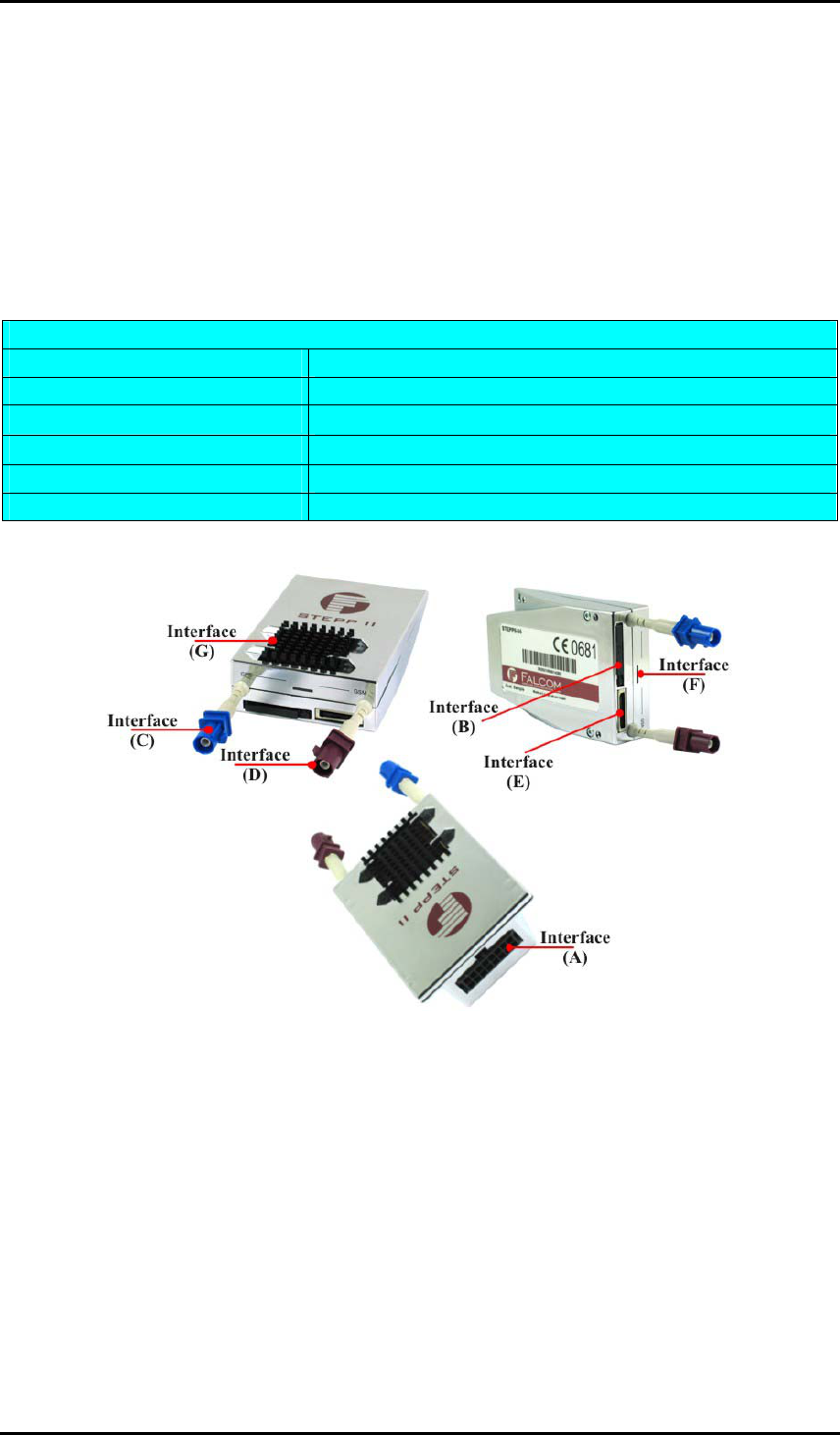
STEPP II HARDWARE DESCRIPTION VERSION 1.01
6 Hardware Interfaces
This chapter describes the hardware interfaces:
• pinout on the 16-pin (Molex) connector
• pinout on the 15-pin (AMP) connector
• RF interfaces
• SIM interface
• LED’s indicator
Interface specifications
Interface A 16-pin Molex 43045-1609
Interface B SIM card reader for small SIM cards (3V)
Interface C GPS RF Connector 50 Ω Fakra/Radiall (SMB-Male)
Interface D GSM RF Connector 50 Ω Fakra/Radiall (SMB-Male)
Interface E 15-pin AMP 5-558556-1
Interface F Optical GSM/GPS LED’s
Table 10: Interface specifications
Figure 3: Interface specifications
This confidential document is a property of FALCOM GmbH and may not be copied or circulated without previous permission.
Page 26

STEPP II HARDWARE DESCRIPTION VERSION 1.01
6.1 Interface A (16-pin Molex 43045-1609)
Figure 4: View of the 16-pin Molex 43045-1609 connector pin assignments
6.1.1 Description of the 16-pin connector
PIN NAME I/O DISCRIPTION LEVEL
1 MIC N1 I(-)
3 MIC P1 I(+)
Balanced microphone
input. Can be used to
directly feed an active
microphone.
If not used leave it open.
RI 50 k differential
VImax = 20 mVpp
2 Analog Input 2 I
4 Analog Input 1 I
General propose analog
inputs
up to 32 V DC/8 bit
resolution
5 Out_2 O
7 Out_1 O
9 Out_3 O
11 Out_4 O
Open collector outputs. 300 mA max. at +10.8
.. +32V DC
6 Inp_4 I
8 Inp_3 I
10 Inp_2 I
12 Inp_1 I
HIGH ≥ +10.8 .. +32 V DC
LOW = 0V
13 IGN I
General propose inputs
10.8 .. 32 V DC
14 VBAT+ I/O
This line is a current
source for an external
battery.
Supplies the terminal with
power if no external
power supply to the
terminal is applied (e.g.:
Vehicle battery).
If not used leave it open.
Do not connect this pin to
the VC+ line or GND.
max. 450 mA at 4.2
VDC
15 VC+ I
Power supply input (Input
7). The power supply
must be able to meet the
requirements of current
consumption in a Tx burst
VI = +10.8 ... +32.0 V
±5 %
Imax 2 A (during Tx
burst)
1 x Tx,
p
eak current
This confidential document is a property of FALCOM GmbH and may not be copied or circulated without previous permission.
Page 27
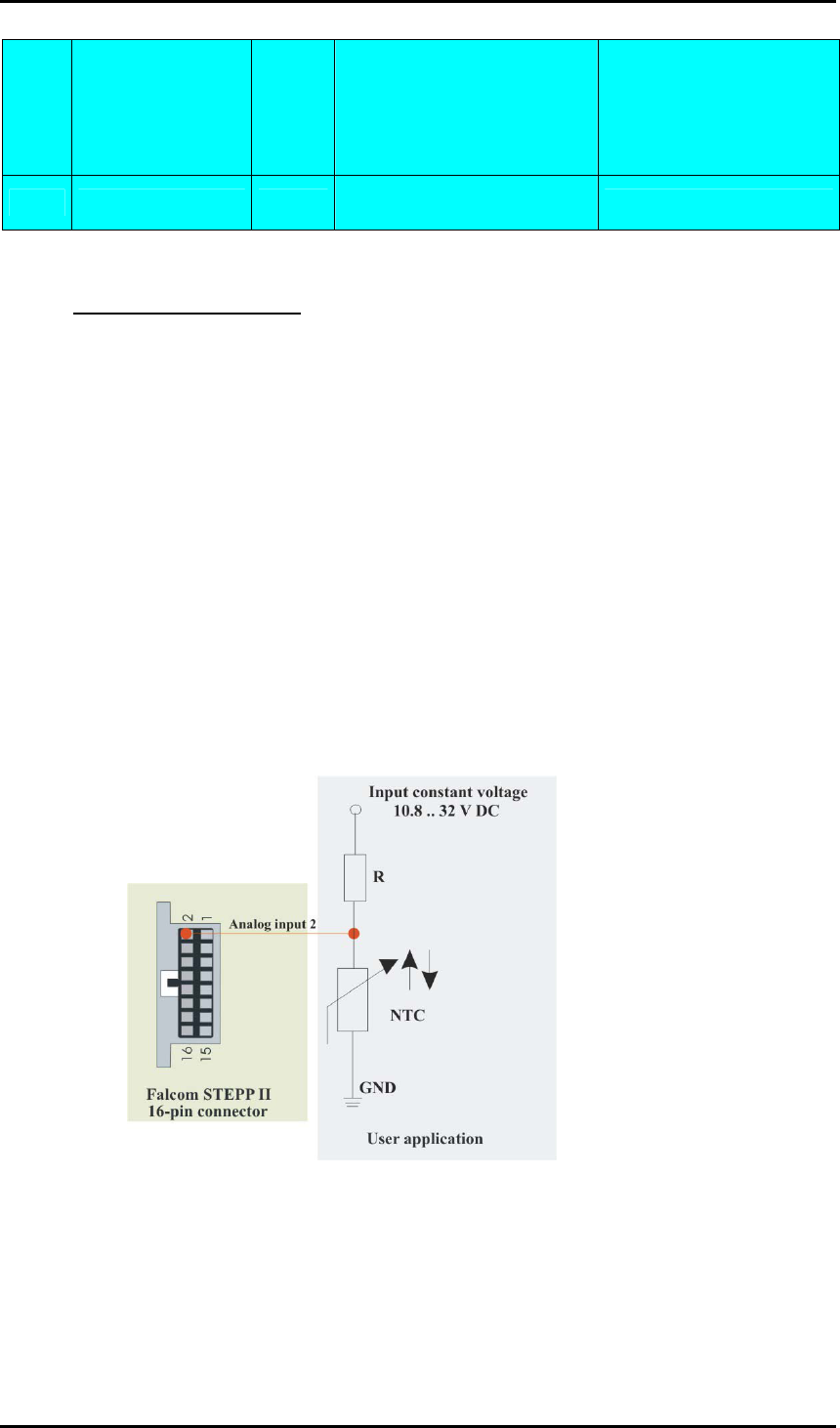
STEPP II HARDWARE DESCRIPTION VERSION 1.01
(up to 2 A). Sending with
two timeslots doubles the
duration of current pulses
to 1154 µs (every
4.616 ms)!
577 µs every 4.616 ms
2 x Tx, peak current
1154 µs every 4.616 ms
16 GND - Negative operating
voltage (ground). 0 V
Table 11: Pin description of 16pin Molex connector
6.1.2 Special pin description
6.1.2.1 Analog inputs (pin 2, 4)
Analog voltages up to 32 V with 8 bit resolution can be processed and
remotely evaluated by a server application. Pull-up resistor to a constant
input voltage allows for resistive transducers to ground, e.g. fuel sensor or
thermistors.
↓ Connection example for analog input 2:
Thus, pin 2 (analog input 2) can be connected to a temperature sensor (a
NTC resistor for instance). It is possible to set a low temperature alarm and
a high temperature alarm (upper and lower values), passed to required
temperature. Passage through these thresholds will trigger an alarm. We
recommend to use SMS as alarm type with the protocol GPIOP (SMS
including voltage values and text. It depends on the user configuration). The
SMS can be received on a mobile phone, modem or any GSM device, see
illustrated example in figure below:
Figure 5: Connection example for analog input 2
This confidential document is a property of FALCOM GmbH and may not be copied or circulated without previous permission.
Page 28

STEPP II HARDWARE DESCRIPTION VERSION 1.01
↓ Connection example for analog input 1:
Likewise, on pin 4 (analog input 1) you can install a tachometer generator.
Its functionality is just like pin 2 (analog input 2). The maximum output
voltage of the tachometer is +32 V (see illustrated example in figure below).
NOTE: Both circuit examples (the NTC (above) and the Tachometer)
are only illustration to show the aim of the analog inputs.
Figure 6: Connection example for analog input 1
6.1.2.2 Inputs (pin 6, 8, 10, 12)
The inputs (pin 6, 8, 10, 12) on the 16-pin connector are high active so they
can be connected to +10.8 ... 32 V DC. The figure below illustrates how to
connect these inputs. If one of connected pins (inputs) is activated (for at
least 1 sec), STEPP II will release an alarm (SMS, Voice or data
connection). The alarm type and the alarm text (alarm type SMS) depend on
the configuration done by the user. The inputs can be configured by using
the configuration software (Configurator_2.2). All inputs reserved for
customer specific applications can be connected as shown below:
Figure 7: Connection example for input 4
A completed circuit example for all inputs is attached in section 10.1.1.
This confidential document is a property of FALCOM GmbH and may not be copied or circulated without previous permission.
Page 29

STEPP II HARDWARE DESCRIPTION VERSION 1.01
6.1.2.3 Outputs (pin 5, 7, 9, 11)
The STEPP II supports four outputs. These can be set remotely by the server
application. The figures below show the schematic of possible output
connections.
Figure 8: Connection example 1 for output 4 (Relay)
Figure 9: Connection example 2 for output 4 (LED)
A completed circuit example for all outputs is attached in section 10.1.1.
6.1.2.4 VBAT (pin 14)
The charging algorithm has been optimized for a Li-Ion battery pack. It is
recommended that the battery pack you want to integrate into your STEPP II
application is compliant with these specifications.
Li-Ion battery pack specified for a maximum charging voltage of 4.2 V
and a capacity of 700 mAh. Battery packs with a capacity down to 600
mAh or more than 800 mAh are allowed, too. Higher capacity of
integrated battery pack offers better functionality of the STEPP II
terminal.
The charging current is limited of 450 mA.
On-board battery circuit with current limiter charging of 450 mA that
charges lead battery constantly.
Ensure that the pack incorporates a protection circuit capable of detecting
over voltage (protection against overcharging), under voltage (protection
against deep discharging) and over current.
This confidential document is a property of FALCOM GmbH and may not be copied or circulated without previous permission.
Page 30
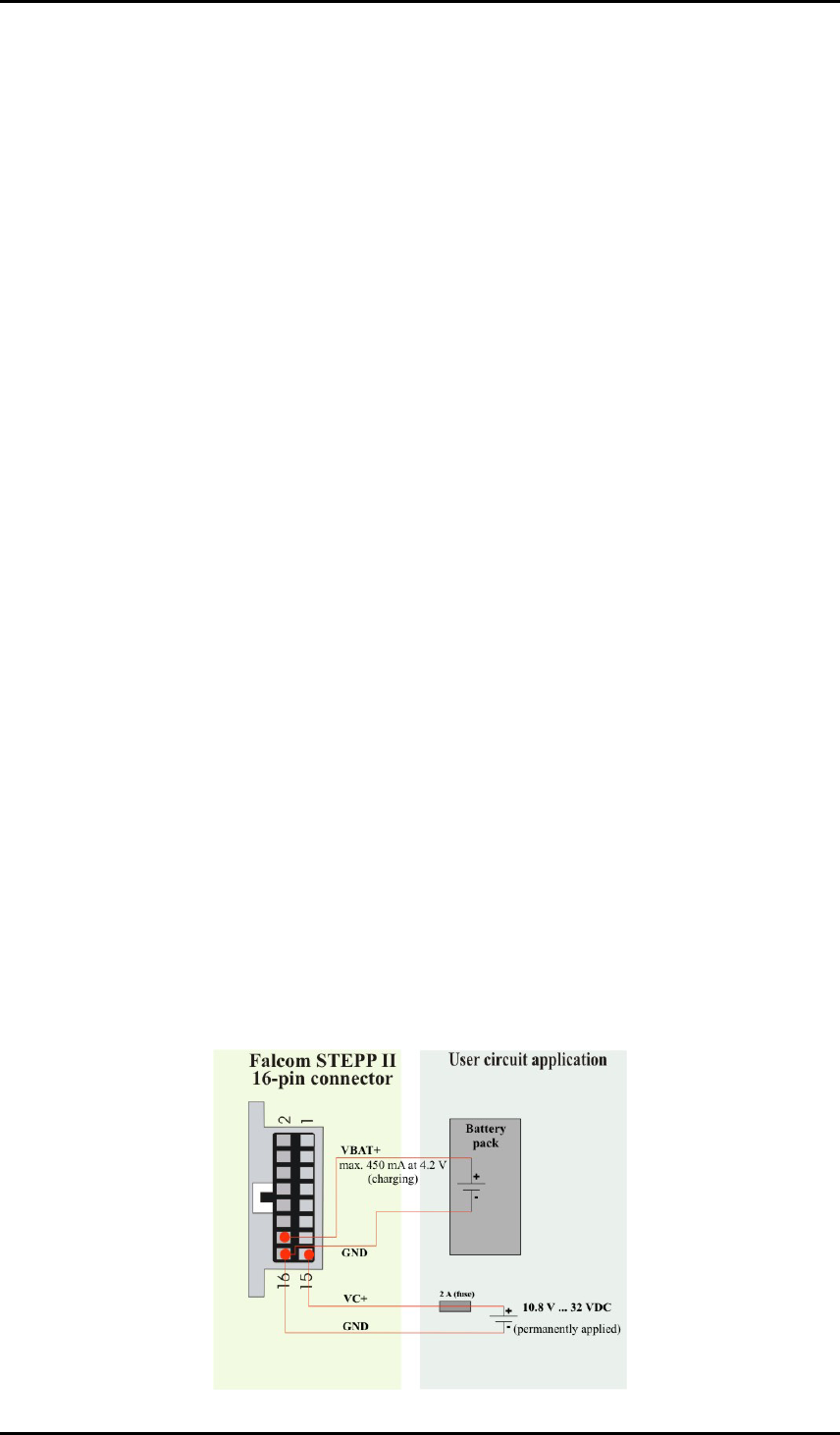
STEPP II HARDWARE DESCRIPTION VERSION 1.01
The internal resistance of the battery and the protection should be as low
as possible. It is recommended not to exceed 150 m, even in extreme
conditions at low temperature. The battery cell must be insensitive to
rupture, fire and gassing under extreme conditions of temperature and
charging (voltage, current).
The contacts of battery pack must be protected from short circuits. For
example, use rubber-band or cable isolation on the contacted parts to
prevent short circuits.
The battery pack must be approved to satisfy the requirements of CE
conformity.
The circuit diagram below shows how to connect a Li-Ion battery to the STEPP
II terminal. The charging/discharging process is implemented internally. The
charging process take place only if the operating voltage is applied. If the
STEPP II is not in use for a long time (e.g. warehouse) this pin (VBAT+) can
be left open (remove the battery).
Warning ! The battery circuit is not protected from reverse pole connection.
To prevent the mounting of battery in reverse polarity, mount it
before the power supply is applied to the terminal. Then check
again the connected wires from STEPP II to external user battery
pack. If they are properly connected, supply the terminal with
external power (i.e. car battery). Otherwise, if battery will be
mounted with reverse pole while the operating voltage (VVC+) is
applied to the terminal, some on-board electronic components of
terminal can be damaged.
!!! Take care not to connect the battery with the wrong polarity.
Caution: 1) Please, keep in mind that the pin (VBAT+) has in no case to be
connected neither to the operating voltage (VVC+) pin nor to the
GND pin.
2) Charging process can only be accomplished in a temperature
range from 0 °C to +40 °C, typically 15 to 25 °C.
The extreme temperatures have an unfavourable influence on
the rechargeable batteries. The capacity and life cycle of the
batteries are reduced if they are kept at cold or warm places,
e.g. in a closed car at summer or winter conditions. Try always
to keep the connected battery (STEPP II) at normal
temperatures between 15 °C and 25 °C.
Figure 10: VBAT+ connection example
This confidential document is a property of FALCOM GmbH and may not be copied or circulated without previous permission.
Page 31

STEPP II HARDWARE DESCRIPTION VERSION 1.01
6.1.2.4.1 Why is required to connect a backup battery
The Li-Ion batteries (e.g. 1100 mA/h) provide sufficient current form which
the STEPP II can also continue to operate (except digital outputs, handsfree set
as well heating/cooling system which do not operate only from the external
battery) in case of operating voltage failures. So, in this way it enables the
STEPP II terminal sending/receiving SMS, establishing a data or voice call or
establishing a GPRS connection.
6.1.2.5 Ignition (pin 13)
STEPP II provides two Ignition pins (pin 13) on the Molex and AMP
connectors. Their functionality is the same. The vehicle ignition line (starter
lock clamp 15) can be connected to one of the IGN pins of terminals (Pin
13). Thus, it is possible to send an alarm SMS (by starting the car engine),
prerequisite, the input IGN of the STEPP II should be configured for this
purpose. Both pins 13 on the Molex connector and AMP connector are
internally connected with each other, so they can be alternatively used. For
more information see the corresponding figure in chapter 10.1.1.
Note that the STEPP II’s IGN pins are not assumed to switch on the STEPP
II terminal, they are only inputs pin which can be used for specific customer
requirements.
Figure 11: Ignition connection example
This confidential document is a property of FALCOM GmbH and may not be copied or circulated without previous permission.
Page 32
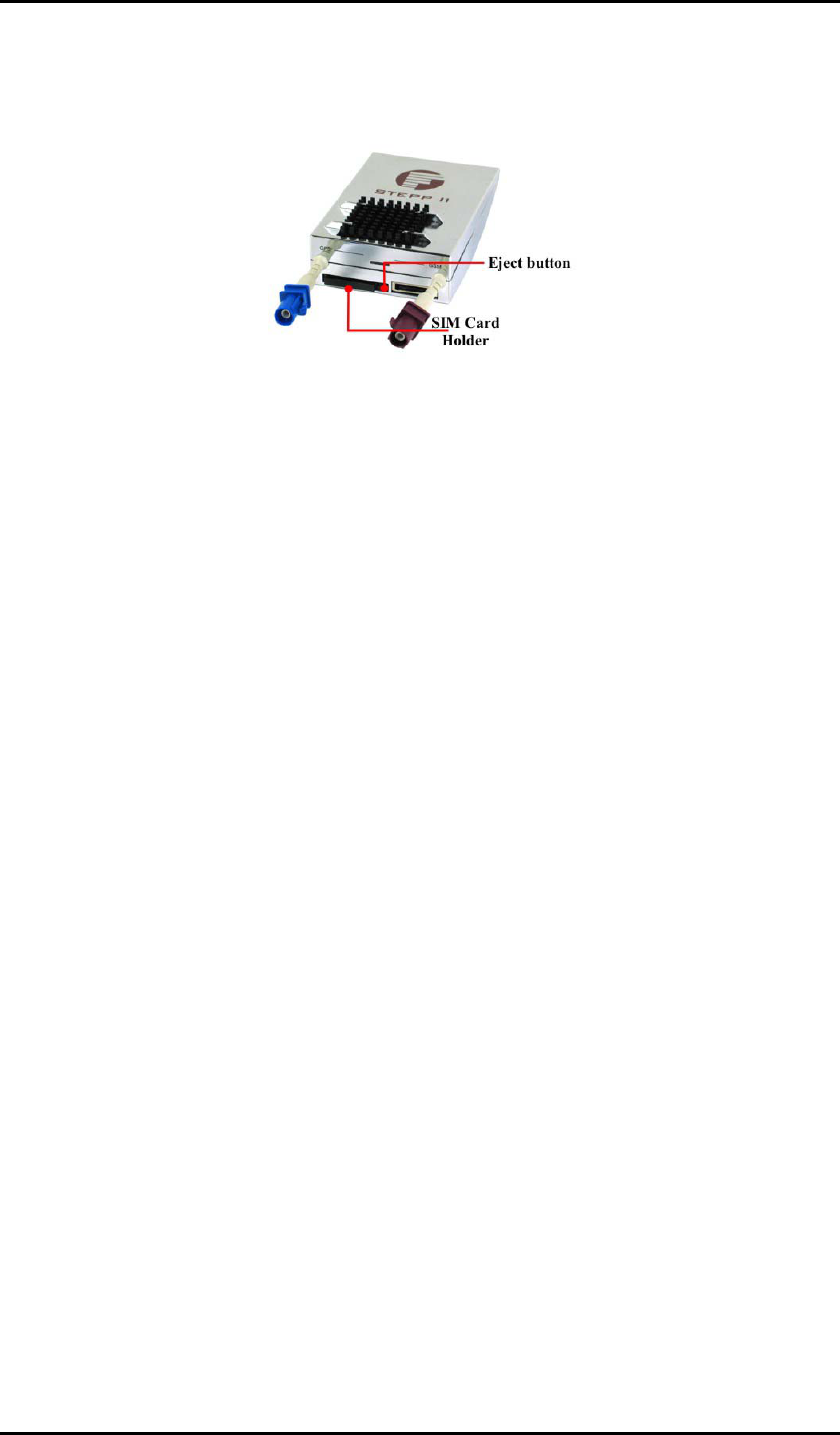
STEPP II HARDWARE DESCRIPTION VERSION 1.01
6.2 Interface B (SIM card interface Molex-91228-0002)
The figure below shows the SIM card reader interface of the STEPP II.
Figure 12: View of the SIM card interface
The SIM interface controls a internal small 3 V SIM card. This interface is
fully compliant with GSM 11.11 recommendations concerning SIM
functions.
Note: The SIM should not be removed, while the module is powered on.
The SIM must only be removed when the STEPP II is shut down.
To remove the SIM card press the Eject button (see figure 12) then
pull out the SIM card holder.
Note: The unit is not designed for use of single 5 V SIM cards. These
cards will generate an error which cannot be distinguished from a
faulty SIM card.
This confidential document is a property of FALCOM GmbH and may not be copied or circulated without previous permission.
Page 33

STEPP II HARDWARE DESCRIPTION VERSION 1.01
6.3 Interfaces C and D
The STEPP II is fitted with two male SMB FAKRA connectors that accept a
wide variety of GSM/GPS antenna styles. One of them (right) (see figure
below), is provided for GSM RF connection. The GSM RF connector has an
impedance of 50 Ω. A GSM antenna can be directly connected to this
connector.
The other left-one is provided for GPS RF connection. The GPS RF connector
(see figure below) has an impedance of 50 Ω. Active antennas have an
integrated low-noise amplifier. They can be directly connected to this
connector. The integrated low-noise amplifier of the antenna is internally
supplied with the specified voltage.
FALCOM GmbH provides a combined GSM/GPS antenna, especially, for the
STEPP devices, the GSM antenna operates on four frequencies: GSM 850/900
MHz and DCS 1800/1900 MHz. The GPS antenna operates on 1575.42 MHz
frequency. This antenna is suitable for mounting, covertly if required, in
various locations.
The order name of combined GSM/GPS antenna is: FAL-ANT-5
Hint: In order to operate properly the GPS part, it is recommended the GPS
active antenna should not exceed 25 mA. The antenna voltage is supplied
internally. The GPS antenna is protected from reverse pole connection.
The figure below shows the position of GSM/GPS connectors.
Figure 13: View of the GSM/GPS antenna cable.
Both GSM/GPS antenna cables with their FAKRA connectors are connected
to STEPP II. Both GSM and GPS antenna cables have the same length.
6.4 Interface E (AMP 558556-1 Connector)
Figure 14: View of the 15-pin AMP5-558556-1 connector pin assignments
This confidential document is a property of FALCOM GmbH and may not be copied or circulated without previous permission.
Page 34

STEPP II HARDWARE DESCRIPTION VERSION 1.01
CAUTION - Insert the 15-pin AMP adapter kindly into the AMP slot of
terminal. Forcing the adapter may damage the connector pins.
If you feel any resistance while inserting the adapter into the
AMP slot of terminal, remove it immediately and check for
any damage of its connector or bend pins.
6.4.1 The 15- pin connector description
PIN NAME I/O DISCRIPTION LEVEL
1 GND - 0 V
2 GND -
Negative operating voltage
(grounds). 0 V
3 SPK N1 O(-)
4 SPK P1
O(+)
Analogue audio interface. Balanced
audio output. Can be used to operate
directly an earpiece. This audio
interface is without amplifier.
If not used leave it open.
VOmax = 1.3
Vpp
5
VC 5 O
Power supply output.
Can be used to supply external
equipment which requires the same
voltage level.
100 mA at 5 V
± 5% VDC
6 VB Battery controller
7 MIC N2 I(-)
8 MIC P2 I(+)
Balanced microphone input. Can be
used to feed directly an active
microphone.
If not used leave it open.
RI 50 k
differential
VImax = 20
mVpp
9 SPK N2 with
amplifier O
10 SPK P2 with
amplifier O
Analogue audio interface. Balanced
audio output. Can be used to operate
directly an earpiece.
If not used leave it open.
8 Ω/1 W
11 Boot select I
STEPP II boots in debug mode if
this pin is set to low. Connect it to
GND in case of firmware update.
For normal operation leave it open.
0 V (ground)
12 NC - Not connected -
13 IGN2 I Input 8 +10.8 ... +32 V
14 RxA RS232 O
15 TxA RS232 I
Serial interface for direct connection
to the host PC (configuration,
evaluation, receiving history data
and others) or to the STEPP II Eval-
Board.
If not used leave open.
V24, ±12 V
Table 12: Pins description of 15-pin AMP connector
6.4.2 Special pin description
6.4.2.1 VC 5
This output can be used to power some external functions. VC 5 has to be
used as a power supply for external user applications which require 100 mA
This confidential document is a property of FALCOM GmbH and may not be copied or circulated without previous permission.
Page 35
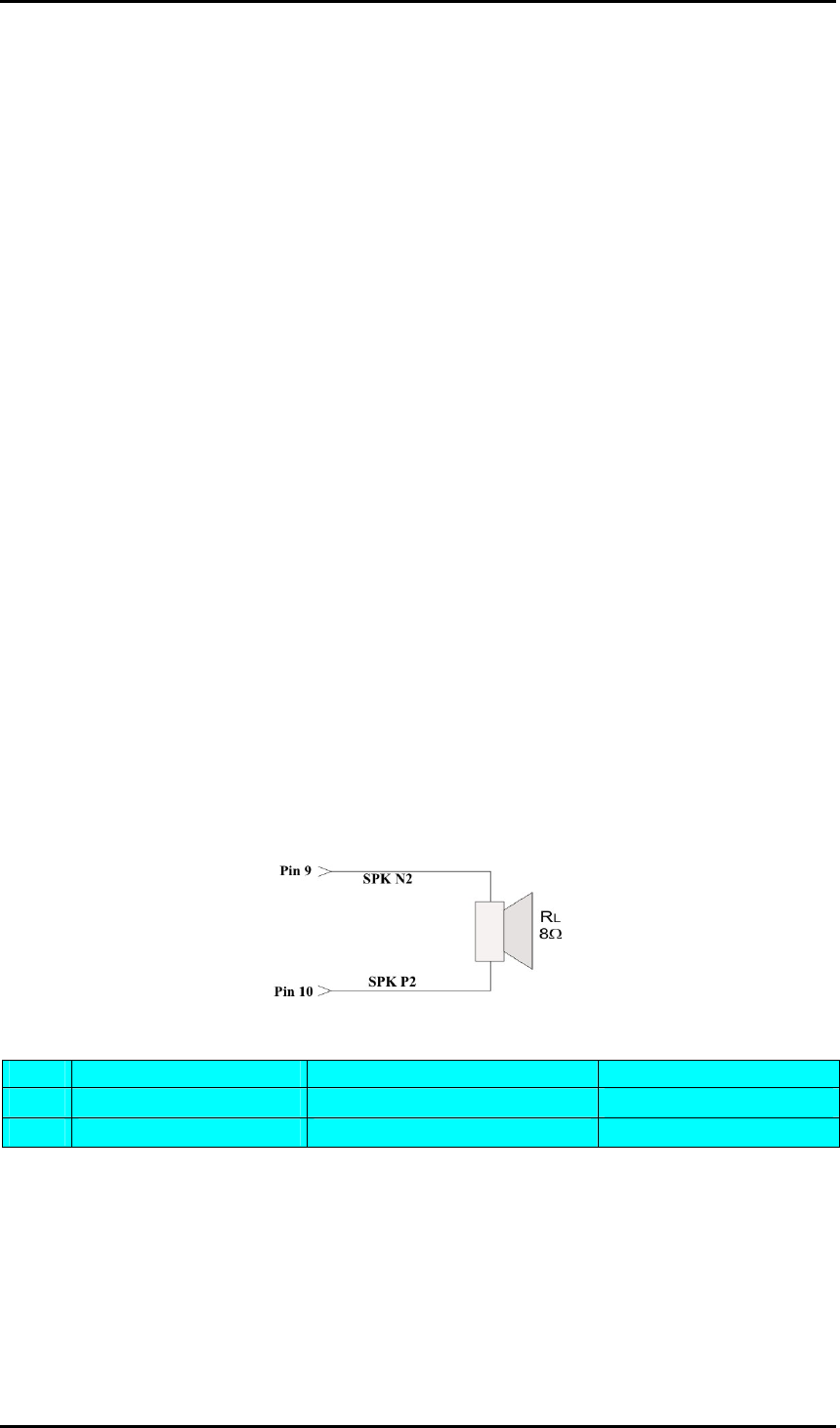
STEPP II HARDWARE DESCRIPTION VERSION 1.01
at 5 V ± 5% VDC. This power supply is available when the terminal is
switched on. To use this pin see chapter 10.1.2.
6.4.2.2 Boot select
To update a new STEPP II firmware, this pin should be linked to GND
(ground). Leave it open for a normal STEPP II operation (tracking, call,
etc.).
6.4.2.3 Serial communication signals (RxA, TxA)
The board supports a full duplex serial channel. The serial connection is at
V24, ±12 V level. You do not need to use any level shifter. The signals on
these pins are obtained to RS232 compatible signal levels. All supported
variable baud rates can be controlled from any terminal software. You can
directly communicate with a PC serial port. It is recommended to use the
STEPP II Eval-Board in order to communicate with terminal.
RxA This is the main receiving channel and is used to
receive software commands to the board from any
terminal software (e.g. HyperTerminal) or from user
written software.
TxA This is the main transmitting channel and is used to
output navigation and measurement data to any
terminal software (e.g. HyperTerminal) or user
written software.
6.4.2.4 Speaker outputs characteristics
A speaker can be connected directly to the pin 9 and pin 10. The standard
level is 8 Ω/1 Watt.
PIN NAME DESCRIPTION LEVEL
9 SPK N2 with amplifier Speaker 2 negative output 8 Ω/1 W
10 SPK P2 with amplifier Speaker 2 positive output 8 Ω/1 W
Table 13: Description of recommended speaker characteristics.
6.5 Interface F (LED’s description)
The actual state of the STEPP II is displayed by three LED’s on the
interface D of the terminal.
The following description shows the function of these LED’s.
This confidential document is a property of FALCOM GmbH and may not be copied or circulated without previous permission.
Page 36
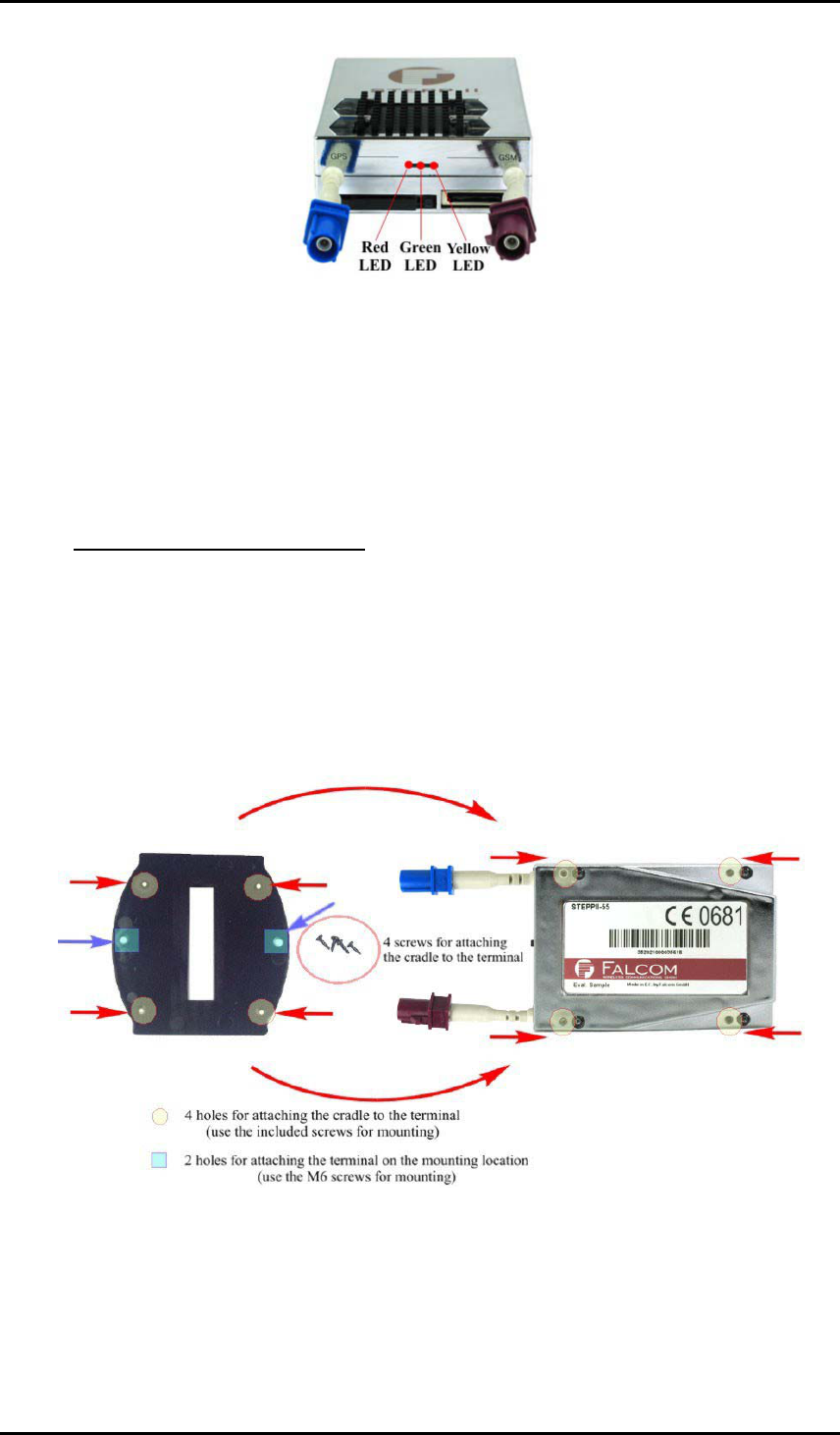
STEPP II HARDWARE DESCRIPTION VERSION 1.01
Figure 15: View of the GSM/GPS LED’s
Three provided LED’s show the actual state of the STEPP II terminal:
Red (Battery): Battery status and ambient temperature (about its
functionality see
Table 8).
Green (GSM): GSM network status (about its functionality see
Table 8).
Yellow (GPS): GPS status (about its functionality see Table 8).
6.5.1 Interface E (Mounting holes)
The STEPP II compact terminal provides 4 holes for attaching it to the suitable
cradle. As a reference for mounting holes use figure 16 below in this section.
The cradle is in the sales package.
In order to avoid any damage during mounting of the terminal, is required to
use (choose if the screws are damaged) properly the screws delivered with
STEPP II. Fasteners are 22 x 6 mm screws plus suitable washers, or
customized screws.
Figure 16: View of the mounting holes
This confidential document is a property of FALCOM GmbH and may not be copied or circulated without previous permission.
Page 37

STEPP II HARDWARE DESCRIPTION VERSION 1.01
6.5.1.1 Mounting the cradle to the terminal
Figure 17: Attached cradle to the terminal.
In order to avoid any damage during mounting, place the terminal (if
needed) on the cradle and push it up/down till you see both terminal and
cradle holes are facing each other. Screws must be inserted with the screw
head on the bottom of cradle through to the provided holes on the bottom of
the STEPP II. Use a suitable screwdriver to perform the rotation. Screw up
kindly the appropriate screws. To avoid short circuits ensure that the
customized screws (screws with different length) do not come into contact
with the STEPP II PCB since there are a number of test points. Make sure
that the STEPP II does not move up and down inside the cradle.
After you have secured up the cradle to the terminal, choose the mounting
location (see next section). The terminal can be mounted in different
locations on a wall or vehicle, metal or non-metal sheets. Its depends on the
user’s application. As a reference for mounting holes use figure 16 (blue
colour).
6.5.1.2 Placing the terminal
Caution: In order to comply with RF exposure requirements, install the
terminal so that a minimum distance of 20 cm can be maintained
between the antenna and persons. If you use an external antenna,
install the antenna so that a minimum distance of 20 cm can be
maintained between the antenna and persons, with antenna gain
not exceeding 3 dBi.
Place mounted terminal in a proper location:
1. The mounting location must be chosen far enough from electronic
devices so that no interference takes place. Please, contact your vehicle
supplier for more information.
2. Make sure the screws are suitable for mounting plate.
3. Drill appropriate screws (M6) the two indentations on the cradle.
4. Secure the cradle and terminal are firmly fixed on the selected mounting
place.
Note: All radio transmitting devices send signals which may cause interference
in different electronic devices (PC, television or electronic devices etc).
To avoid interference, place the terminal far enough from other electronic
devices.
This confidential document is a property of FALCOM GmbH and may not be copied or circulated without previous permission.
Page 38

STEPP II HARDWARE DESCRIPTION VERSION 1.01
7 Housing
The housing material: Galvano-ABS, gloss-chromium-plated.
55
80
25
Figure 18: Housing of the STEPP II.
This confidential document is a property of FALCOM GmbH and may not be copied or circulated without previous permission.
Page 39
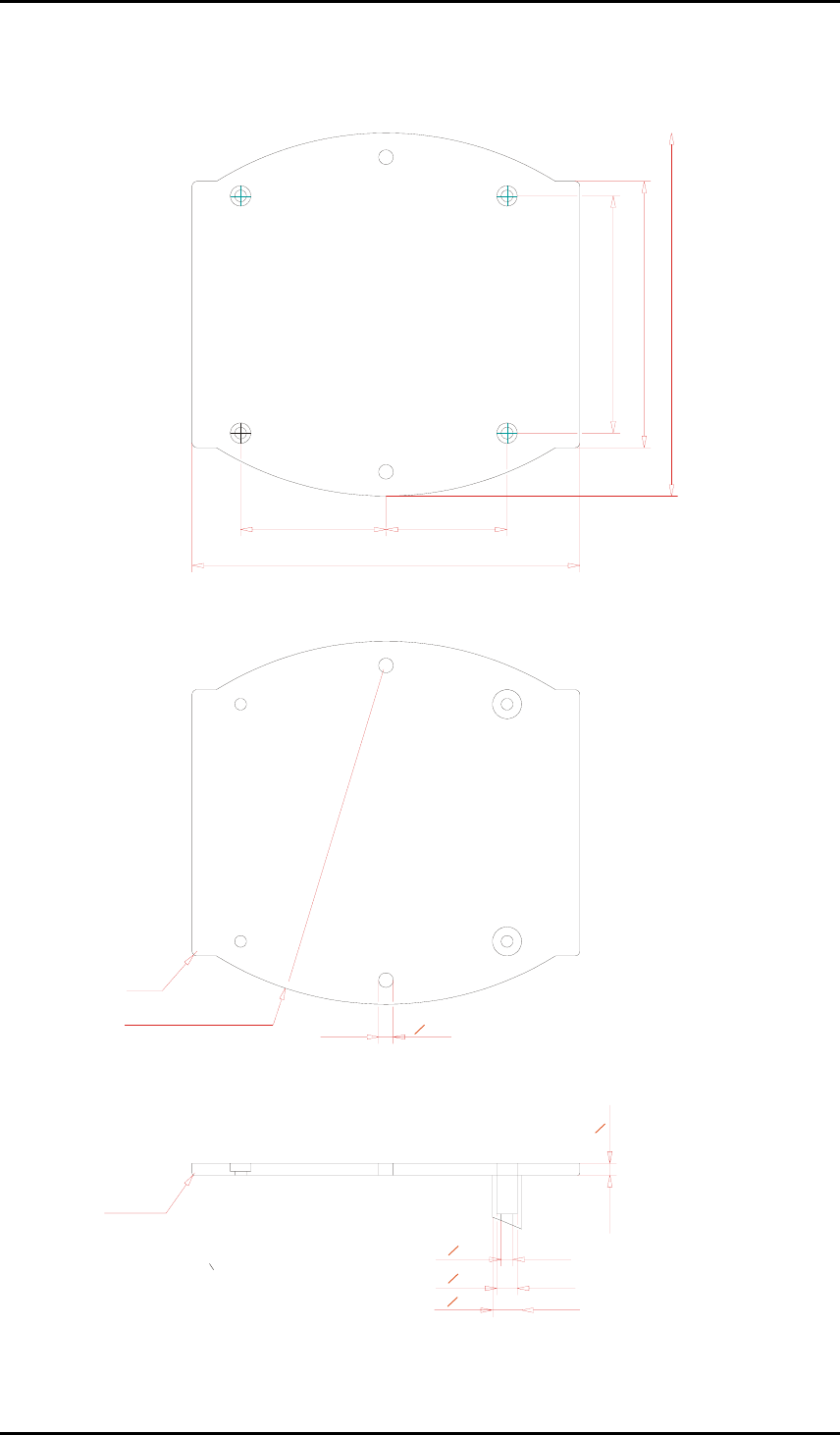
STEPP II HARDWARE DESCRIPTION VERSION 1.01
8 STEPP II-Mounting cradle
2530
80
49
55
75
O 2.5
O 3
O 2.4
O 4.2
O 6
R0.5
R1
R66.25
Figure 19: Mounting cradle of the STEPP II
This confidential document is a property of FALCOM GmbH and may not be copied or circulated without previous permission.
Page 40

STEPP II HARDWARE DESCRIPTION VERSION 1.01
9 RF Exposures
This device contains 850/1800/1900 MHz GSM/GPRS functions that are
operational in these frequencies respectively.
The STEPP II/56 terminal contains 1800 MHz GSM functions that is not
operational (must not be used) in U.S. Territories. This filing is only
applicable for 850MHz GSM/1900 MHz PCS operations, whereby only
these frequencies (850MHz GSM/1900 MHz PCS) are possible to be used
in U.S. Territories.
The external antennas used for this mobile transmitter must provide a
separation distance of at least 20 cm from all persons and must not be
co-located or operating in conjunction with any other antenna or
transmitter.
Statement according to FCC part 15.19:
This device complies with Part 15 of the FCC Rules. Operation is subject
to the following two conditions:
(1) this device may not cause harmful interference, and
(2) this device must accept any interference received, including
interference that may cause undesired operation.
Statement according to FCC part 15.21:
Modifications not expressly approved by this company could void the user's
authority to operate the equipment.
Statement according to FCC part 15.105:
NOTE: This equipment has been tested and found to comply with the
limits for a Class B digital device, pursuant to Part 15 of the FCC Rules.
These limits are designed to provide reasonable protection against harmful
interference in a residential installation. This equipment generates, uses
and can radiate radio frequency energy and, if not installed and used in
accordance with the instructions, may cause harmful interference to radio
communications.
However, there is no guarantee that interference will not occur in a
particular installation. If this equipment does cause harmful interference
to radio or television reception, which can be determined by turning the
equipment off and on, the user is encouraged to try to correct the
interference by one or more of the following measures:
• Reorient or relocate the receiving antenna.
• Increase the separation between the equipment and receiver.
• Connect the equipment into an outlet on a circuit different from that to
which the receiver is connected.
• Consult the dealer or an experienced radio/TV technician for help
This confidential document is a property of FALCOM GmbH and may not be copied or circulated without previous permission.
Page 41

STEPP II HARDWARE DESCRIPTION VERSION 1.01
10 Appendix
10.1 Schematics
The figures below illustrate the recommended schematics for the connection of
the 16-pin Molex and 15-pin AMP connectors.
10.1.1 Installation guidance for 16-pin Molex connector
On the top of the schematic the corresponding pin out of the 16-pin Molex
connector can be found.
A general purpose terminal providing multiple digital and analogue inputs as
well outputs for a variety of uses.
The STEPP II comprises 7 inputs, 4 outputs and 2 analog inputs.
Of the 7 inputs, 4 inputs are free available for the user application. Three of the
inputs are predefined by the manufacturer as below:
- 1 x Power supply which has to be connected to the vehicle battery
(clamp 30).
- 2 x Ignition lines from them one can be connected to the vehicle
starter lock (clamp 15). It can be used to trigger an
alarm SMS when clamp 15 (ignition contact) of the
vehicle is closed (engine of vehicle started). These
pins are not provided to switch ON/OFF the STEPP II
terminal.
4 digital inputs can be used to trigger any alarm type (SMS, voice or data), i.e.
they can be connected to the car alarms or to a door switch, etc.
4 digital outputs are useful to switch remotely ON/OFF an external device. A
schematic below in this section shows how digital inputs/outputs can be used.
Note that all provided outputs have to be used on the same level to the
operating voltage (VVC+).
Ensure that the operating voltage (VVC+) of the terminal and external power
source (i.e. car battery) incorporates a protection circuit against over voltage,
which has to be limited to 2 A at +10.8 … +32 VDC. See circuit diagram
below.
A microphone can be connected to pin 1 and pin 3 of the 16-pin Molex
connector. The figure 20 shows an example for the installation of the STEPP
II-I/O’s in a motor vehicle.
This confidential document is a property of FALCOM GmbH and may not be copied or circulated without previous permission.
Page 42

STEPP II HARDWARE DESCRIPTION VERSION 1.01
Figure 20: Schematic example of installation guidance
10.1.2 Installation guidance for 15-pin AMP connector
Figure 21 shows an example of an installation that enables voice
communication. STEPP II supports two differential microphone inputs and two
differential speaker outputs. The integrated amplifier allows direct connection
of a Hands-Free-set to Pin 9 and Pin 10.
Please, note that the integrated audio interfaces are predefined on the
embedded internal firmware as voice and alarm channels, where by pins (7, 8,
9 and 10) provided on the 15-pin AMP connector support voice channel and
pins (1 and 3) provided on the 16-pin Molex connector support alarm channel.
Figure 21: Possible installation for enabling voice connection.
This confidential document is a property of FALCOM GmbH and may not be copied or circulated without previous permission.
Page 43

STEPP II HARDWARE DESCRIPTION VERSION 1.01
Voice channel
The voice channel allows you to conduct a normal telephone conversation with
the FALCOM STEPP II. For this, FALCOM STEPP II operates in Hands-Free
mode. Requirements are to connect a loud speaker to the pins 9 and 10 and a
Hands-Free microphone to the pins 7 and 8 of the FALCOM STEPP II 15-pin
connector. FALCOM STEPP II will automatically answer an incoming call
after the second or third ring.
Alarm channel
The alarm channel allows you to establish a voice call (listen-in mode) to
the FALCOM STEPP II, without activating the loud speaker interface on
the FALCOM STEPP II. In this case, connect a Hands-Free microphone to
pins 1 and 3 of the FALCOM STEPP II 16-pin connector.
This confidential document is a property of FALCOM GmbH and may not be copied or circulated without previous permission.
Page 44